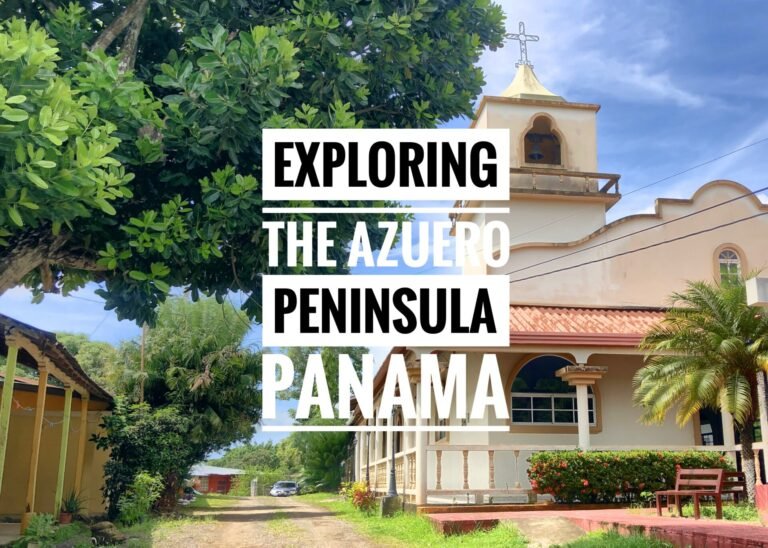
Iguazú Falls is one of those visceral awe-inspiring experiences that everyone should experience once in their lifetime. The earth’s largest waterfall (closely contested with Victoria) has a wingspan of nearly three kilometers (1.8 miles) of pummeling cascades, which are stitched together on the Brazil/Argentina border. It is ringed by luscious subtropical rainforests teeming with flitting colorful butterflies, melodious birds and frisky monkeys. If it’s not already on your life list…add it. It’s a memory that you’ll never forget.
Getting There
At the end of September 2023, we reluctantly re-homed our belongings into our very unpacked backpacks in Buenos Aires and piled onto an 18-hour bus ride in “cama ejecutivo” seats. A bus that, like in Peru, never stopped once (yes, it had a toilet). We were bound for warmer climates, earlier sunrises and an abundance of falling water, but not without some adventures first, of course.


Before we boarded our ride with no meal stops, we knew a good meal was crucial so we loaded up on ramen. Mandy’s vegan kimchi version is pictured. Is it bizarre we had Japanese food three times in Buenos Aires?! Guess we are in the mood these days. Maybe we should go? A bowl cost about $5 on the blue dollar in Buenos Aires. Pretty sure we won’t find these prices in Tokyo.
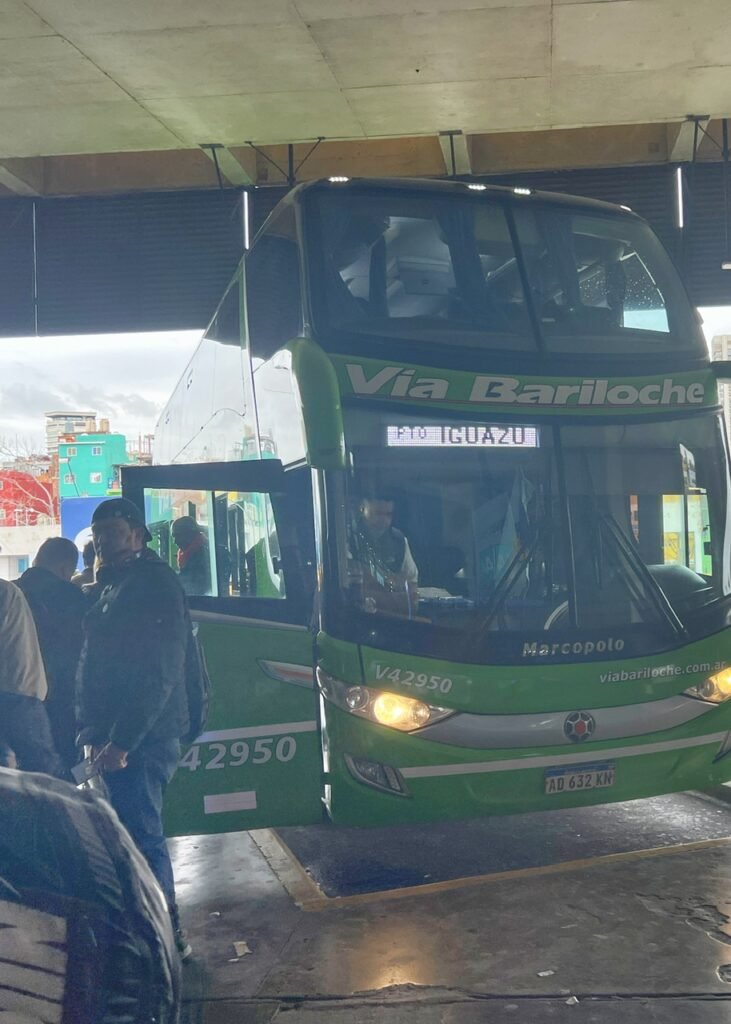
At this point, we were a bit behind so we hustled back to our apartment to call a seriously snail-paced Uber to take us to the main bus station. After someone nearly stole our ride, and sitting in a hella lotta traffic for way too long on a Tuesday afternoon, we had to literally sprint through the station (con todo luggage, claro), to catch our bus after promising our driver a big tip if he put the pedal to the metal. We made it with about five minutes to spare…a travel error we haven’t made in a LONG time. Ugh. Ah well. Good to have these reminders of why we always arrive to the station and hour before?!
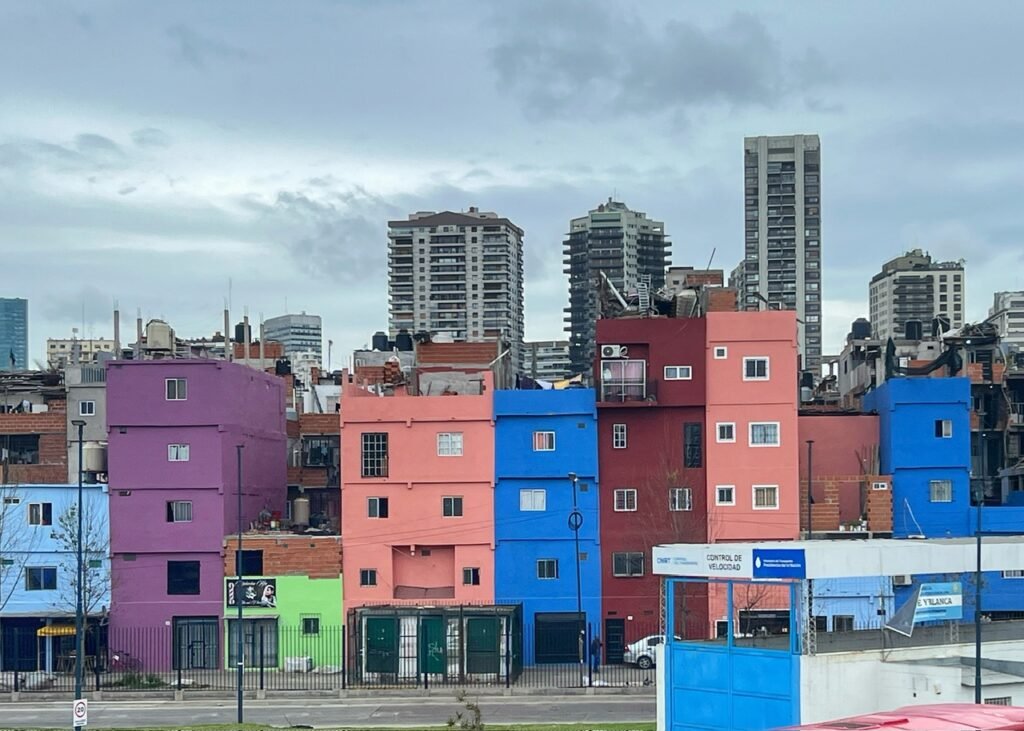
Catching our breath as we caught a glimpse of the crayola-colored neighborhood behind the station. Last time we tried to walk through this area, we realized it was a bit dodgy.
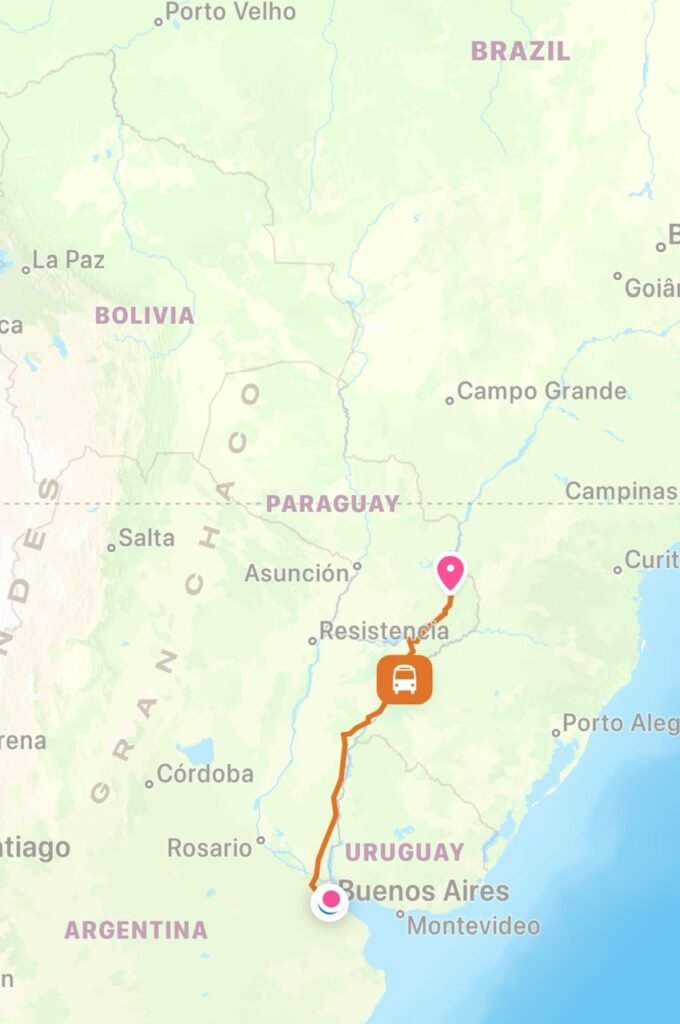


Our journey Northeast Argentina that lasted the next 18 hours. Thankfully we had very comfy seats which folded down almost horizontally because they were only $3 more, and Malbec in a Smart Water bottle because we like to keep it classy. 😂 The plush, luxury seats for this journey cost us $24/each, which is an insane value for 18 hours considering we paid the same for a 4-hour journey in Brasil. (Yes, again blue dollar rate). There was also no loud action movies with two dudes stabbing each other repeatedly for hours on end like in Colombia or Ecuador. Big wins for buses in ArgentinaThe trade off is, you don’t get to stop to eat or stretch. Fortunately we had brought enough food to sustain us. Meh.
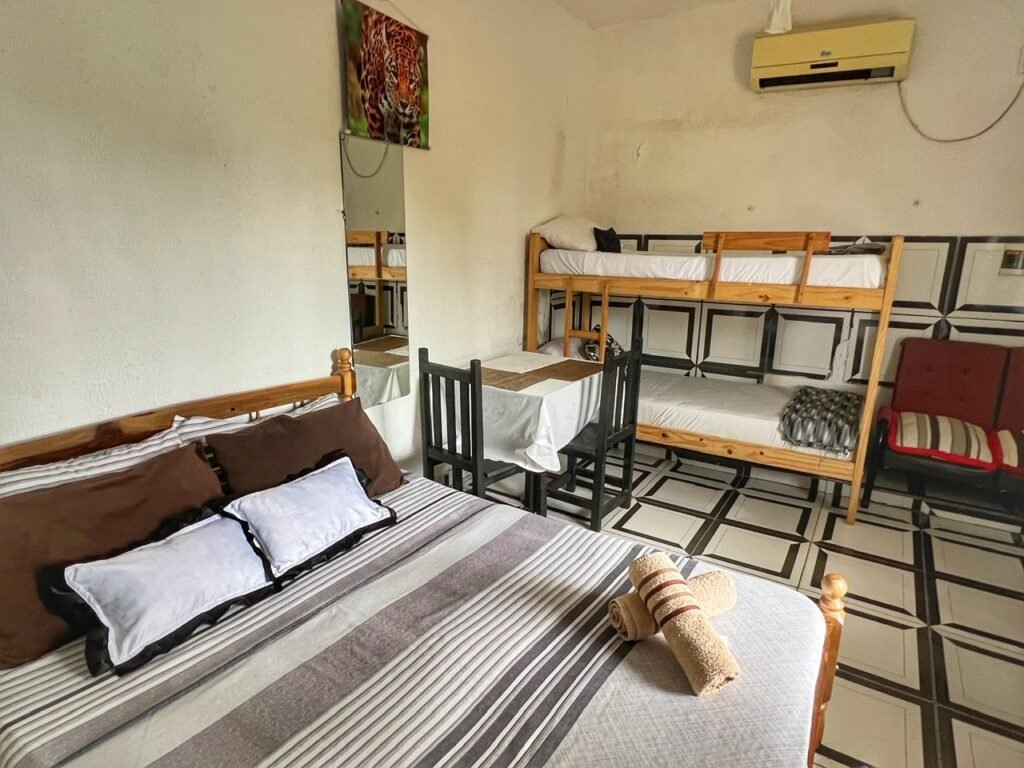

We arrived to the very northern tip of Argentina, Puerto Iguazú, at 11 am and fortunately the owner at Hostal Demaris let us check in right away to our one bedroom/private bath suite with A/C. Welcome to officially the least expensive hotel room we’ve ever had in our lives…$6300 pesos, or what equates to $8.91.
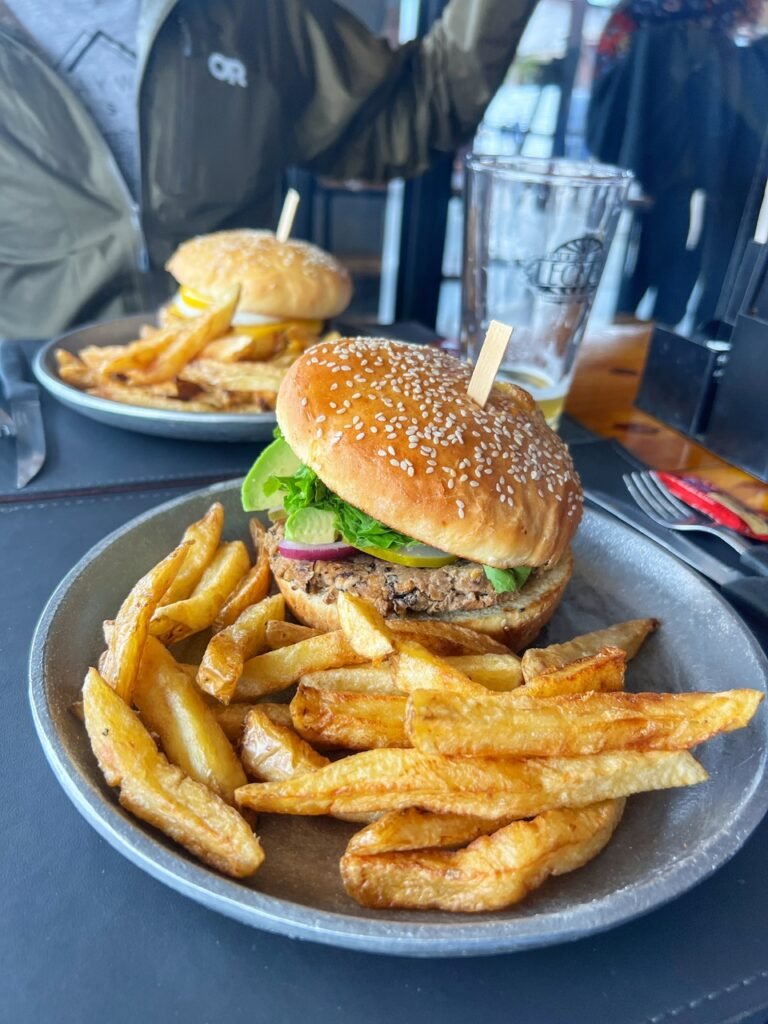

It was about a 20-minute walk to the Main Street of Puerto Iguazu and the main bus station and most of the food options, including these burgers we grabbed to fill our vacant bus tummies. Mandy was elated they had a “Nueva Delhi” veg option! We got two burgers and two pints of craft beer for $13. Prices are still very reasonable despite it being a tourist town. Puerto Iguazu was basically the polar opposite of most border towns we’ve been to…incredibly touristy and not the least bit seedy. Makes sense when you’re housing a world wonder, I suppose.
La Case Ecologia de Botellas (House of Bottles)
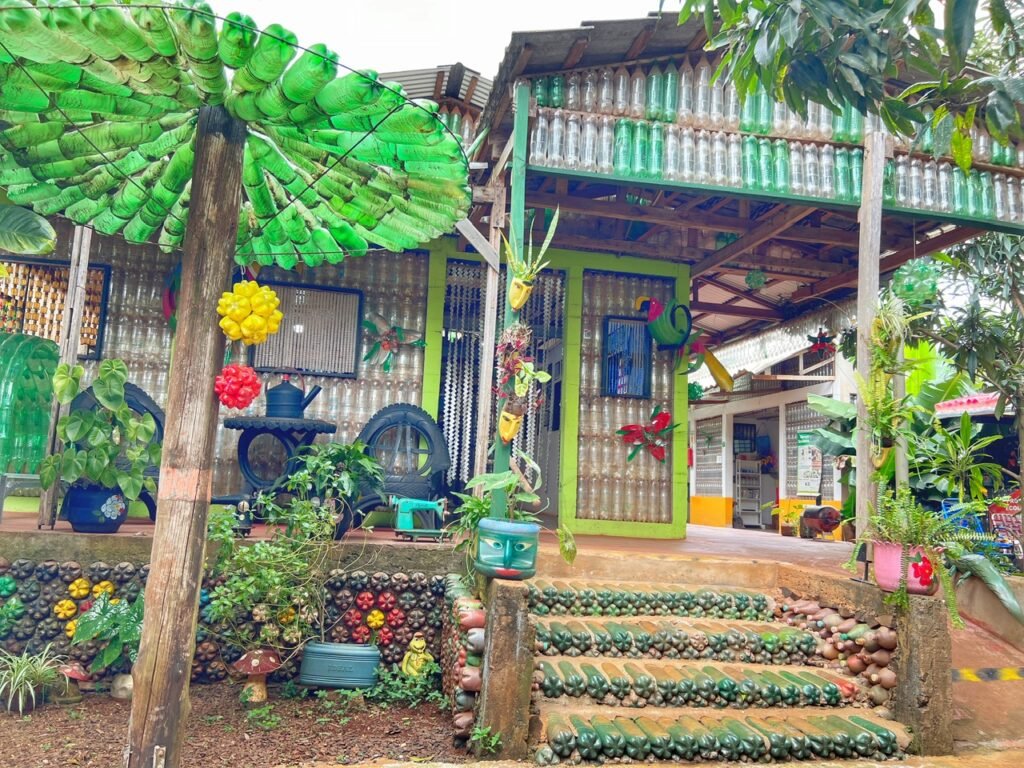
When we were arrived to Puerto Iguazú, we were very bummed to learn that Iguazu Falls had closed its doors for the day, upending our entire plans for the next three days. Thus, we shuffled things around to ensure two days on the Argentina side and looked forward to other less nature-based mind-blowing activities, and more based on the mind-blowing things you can do with…trash. Thanks to Atlas Obscura, we found that in Puerto Iguazu, there is a house made entirely of garbage. It was built by a family of craftsmen to exemplify the concept of ingenious self-sustainability.
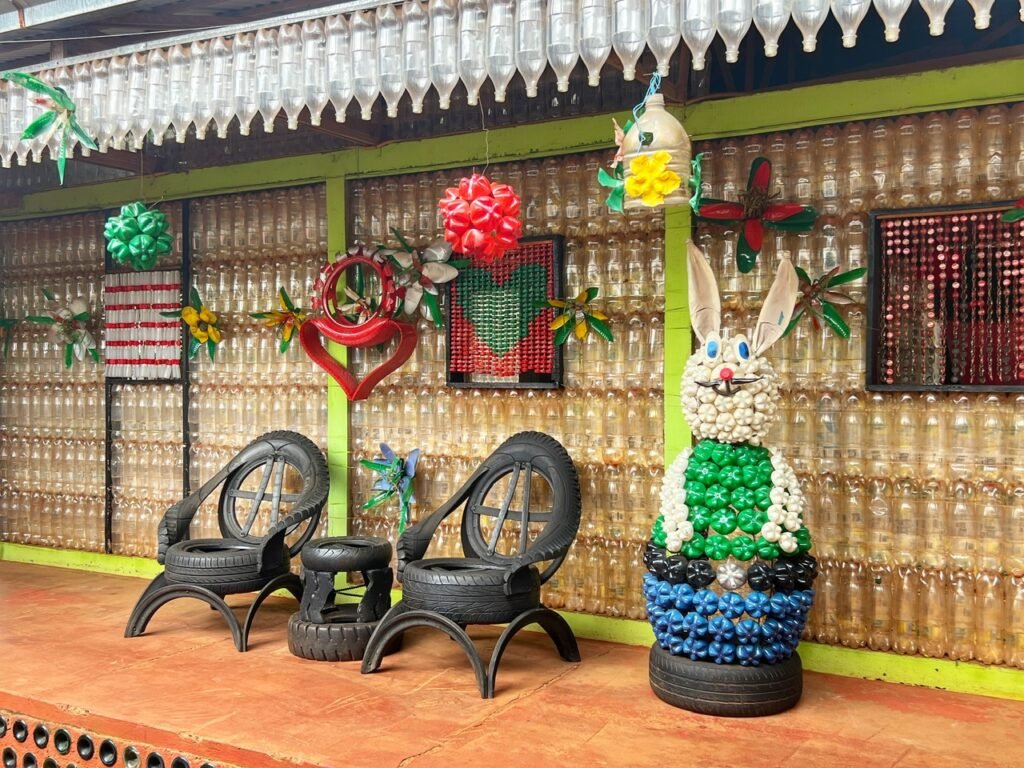
Alfredo Santa Cruz and his family built the bottle house out of trash and recyclables they collected. Aluminum cans, glass jars, CDs, cardboard cartons, and of course, plastic bottles were all used as construction materials. The house has multiple rooms, and even furniture constructed from all these items. Lights and bird feeders from bottles, chairs from tires and a bunny friend made from a little bit of both.
Despite the fact that it’s made from trash, the house is surprisingly beautiful. Sunlight is diluted through the green, brown, and clear bottles, casting mottled shadows on the ground.
The house demonstrates how humans can interrupt their pattern of negative environmental impact. Objects one would usually discard might have a second life as a flower pot, or as a beaded shower curtain. The Santa Cruzes have partnered with the city and with local schools for further ecological improvements to the house, such as a solar water heating system and a self-sustaining agriculture project.
The main purpose of the house and tour is not to demonstrate the ingenuity of the project itself, but to promote the importance of reducing waste and preserving the environment.” (Atlas Obscura App)
The property is open for Spanish-speaking tours only and cost 2000 Argentinian Pesos each, our about $3.
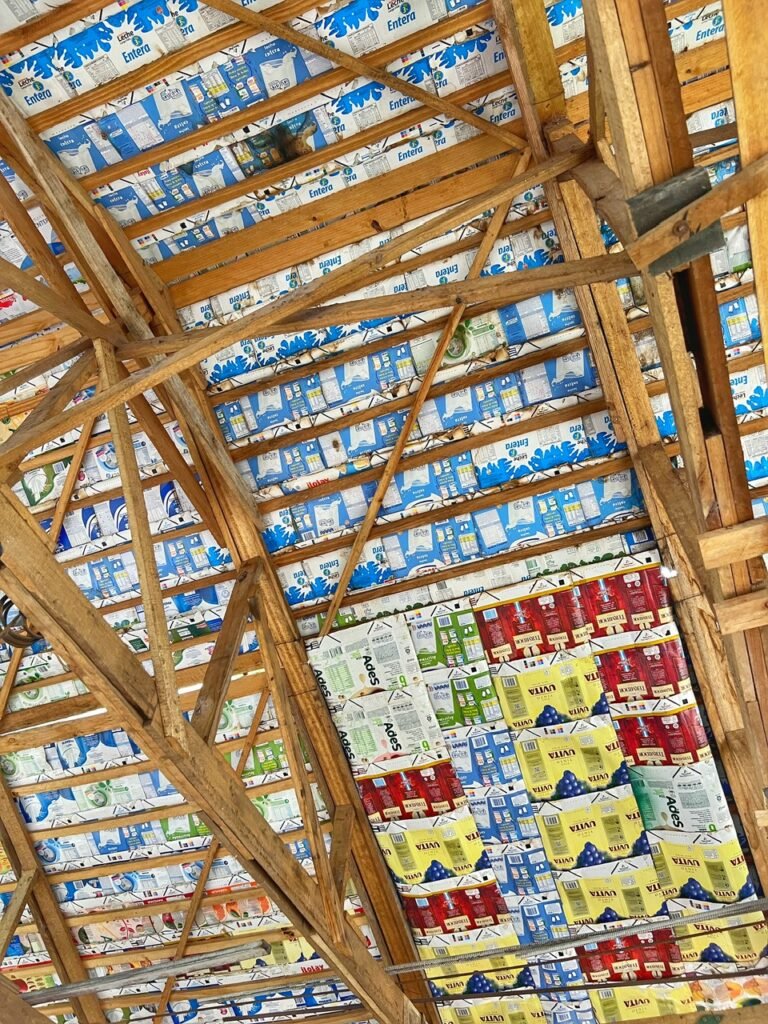

The roof is made entirely of milk cartons and the stairs made from bottles filled with sand.
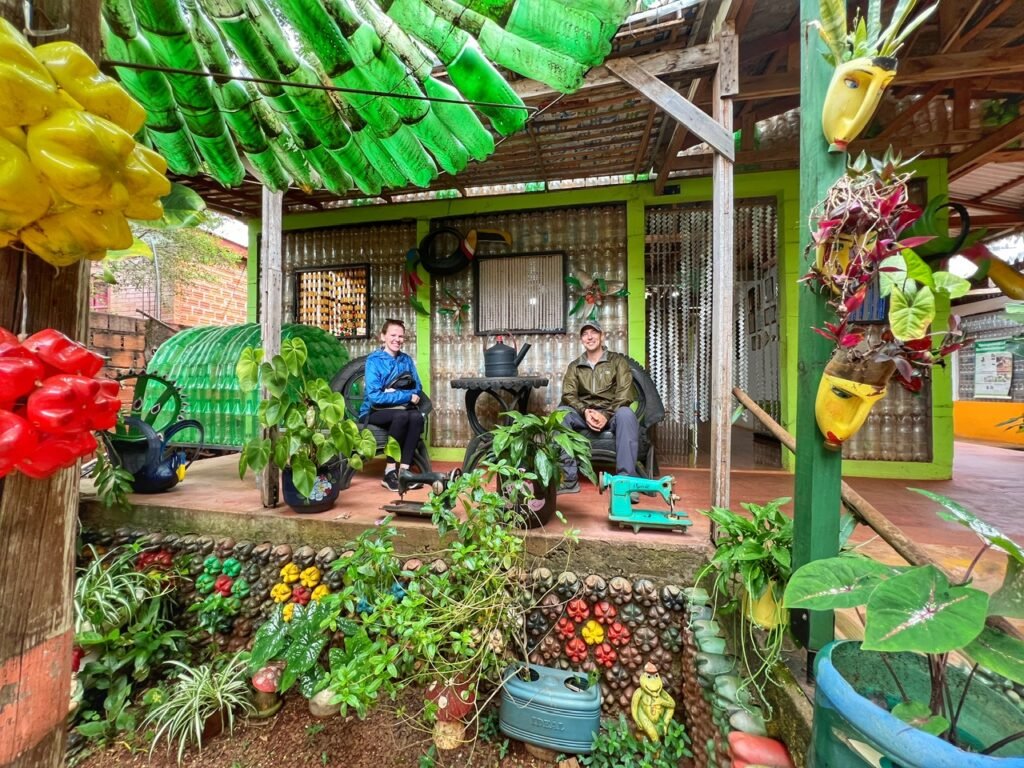
Imagine saying hello to your neighbors from this porch. They might have the impression that the owners of the house were a little batty?
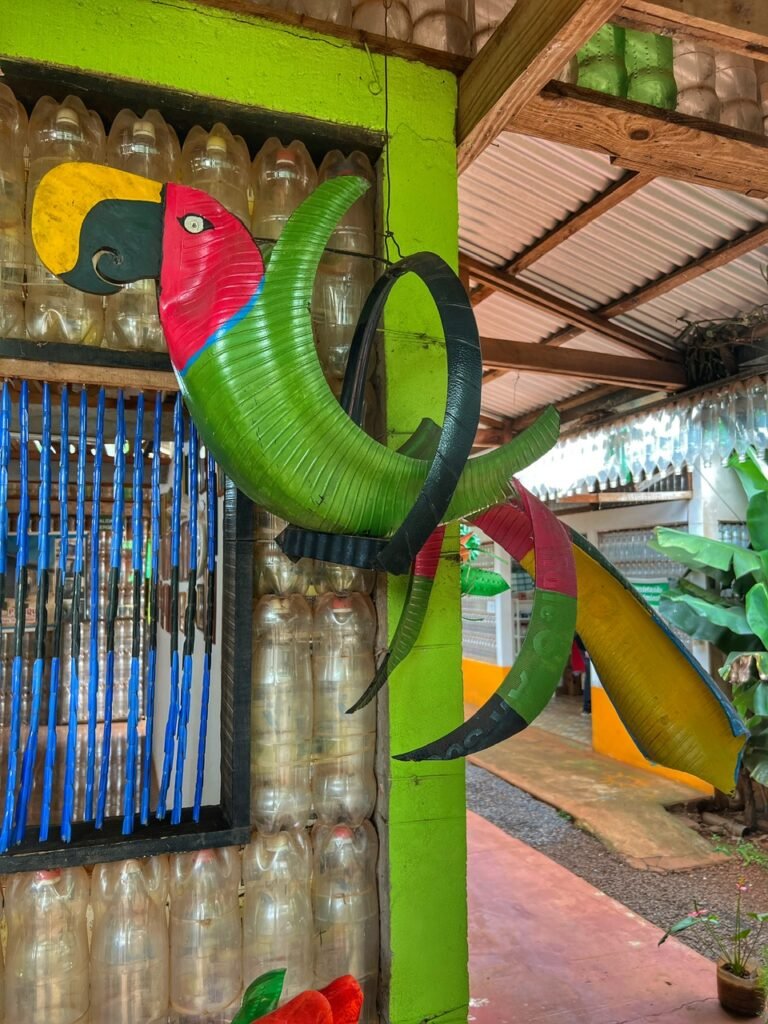
Curtains made from pen caps and a toucan made from tires.

A panorama of the living area.
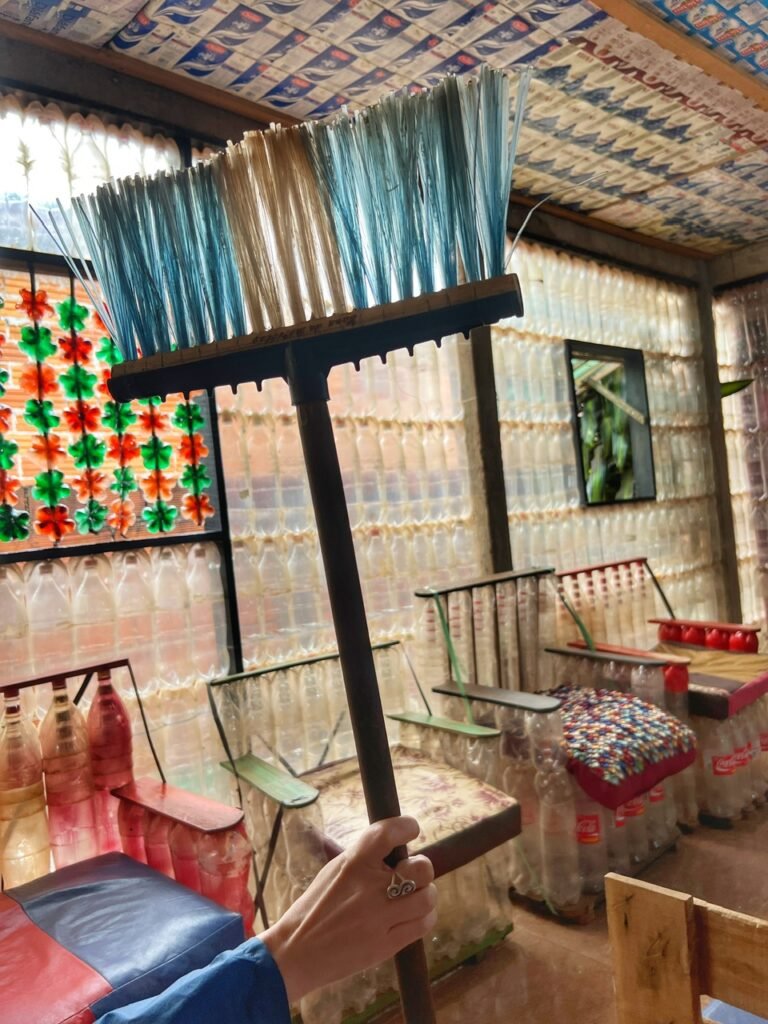
A broom made from the strings of plastic bottles.
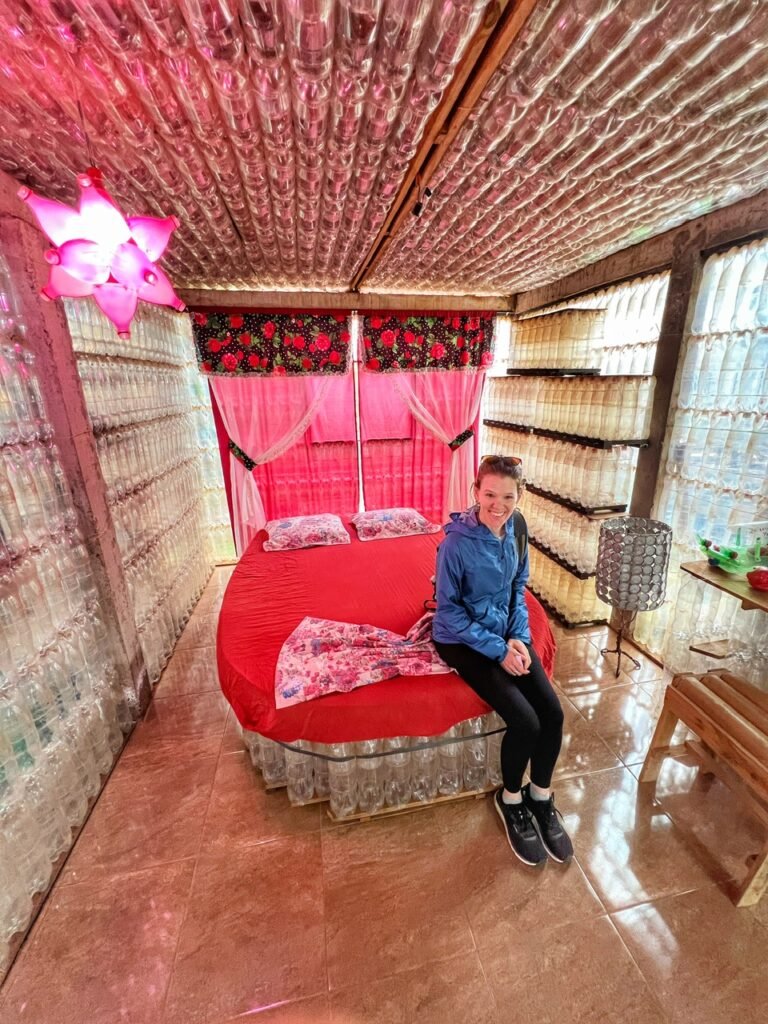
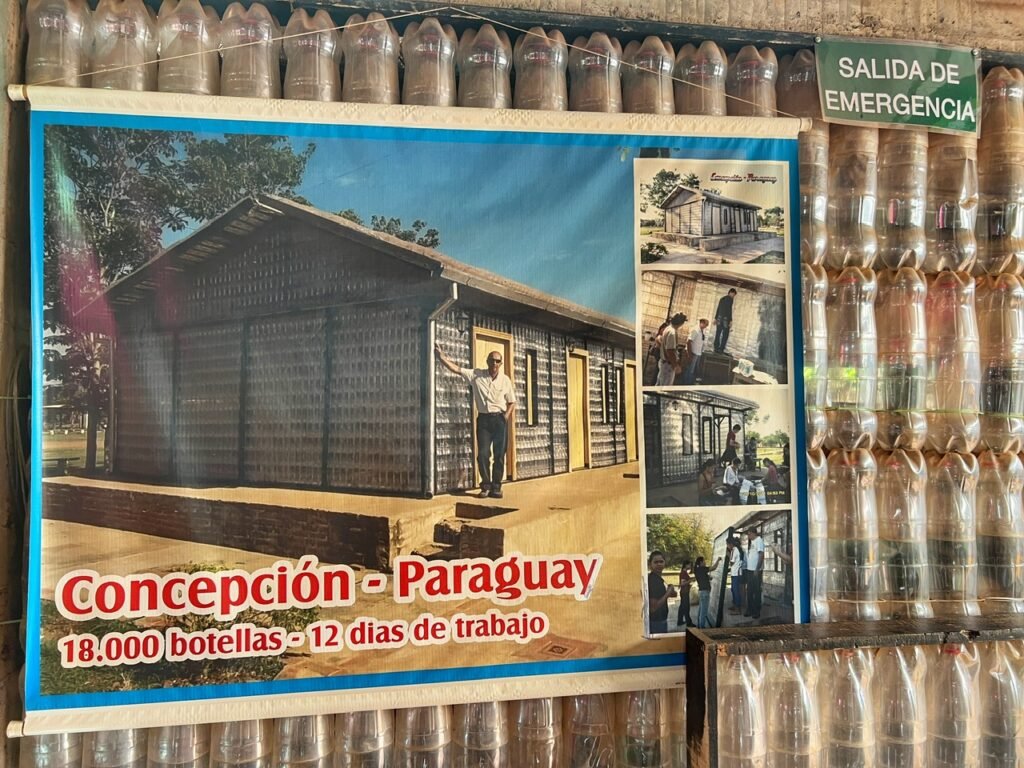
Maybe not the most sexy bedroom in the world? Haha. Another property they’re building in Paraguay. Remarkably this mind-blowing house only takes 12 days to build. Seriously…how amazing!! If only we could all be this resourceful!!
Tres Fronteras (Three Borders)

Mandy climbed in the U for the time being.

We had arrived to our second tri-country border, or tres fronteras of the year. Although this one isn’t an open border concept like the one in Leticia, Colombia, it’s a bit geographically more impressive because you can visibly see all three countries from one vantage point where the Paraña & Iguazu Rivers merge in a very obvious crossroads. The official signage looks like medal platforms for World Cup champions.
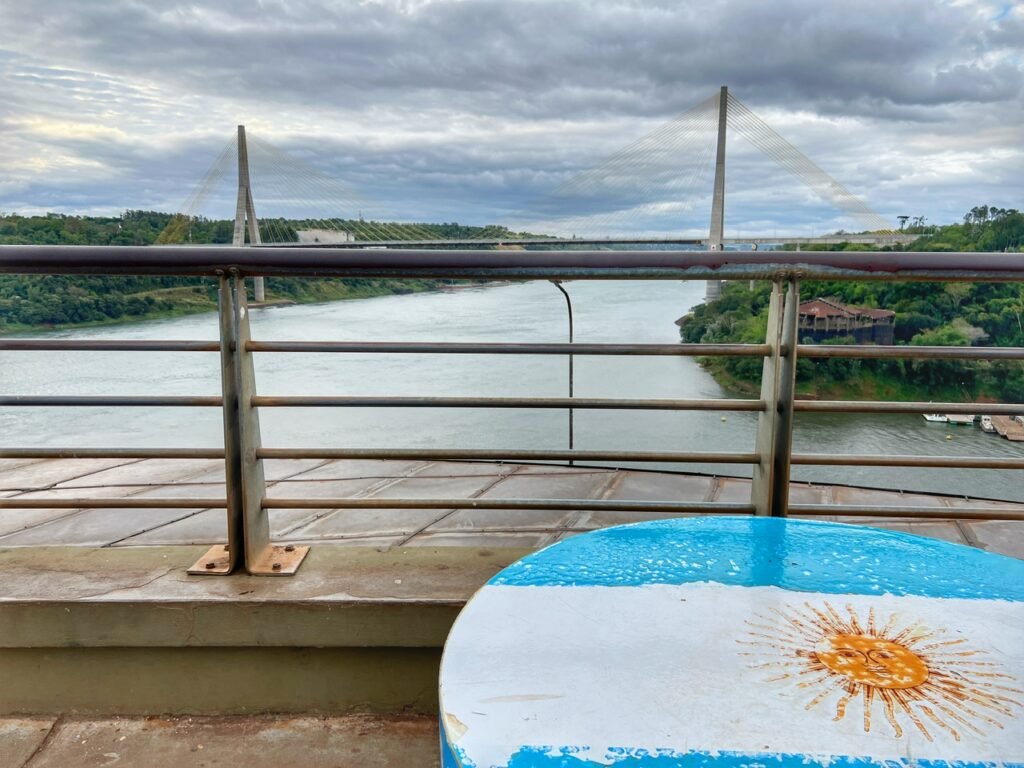
This is the bridge that connects Brazil and Paraguay. The water here interestingly flows from east to west and then south towards Buenos Aires. It was bizarre how slow meandering and tranquil it seemed, especially knowing the hydro-monstrosity that looms a few kilometers upstream.
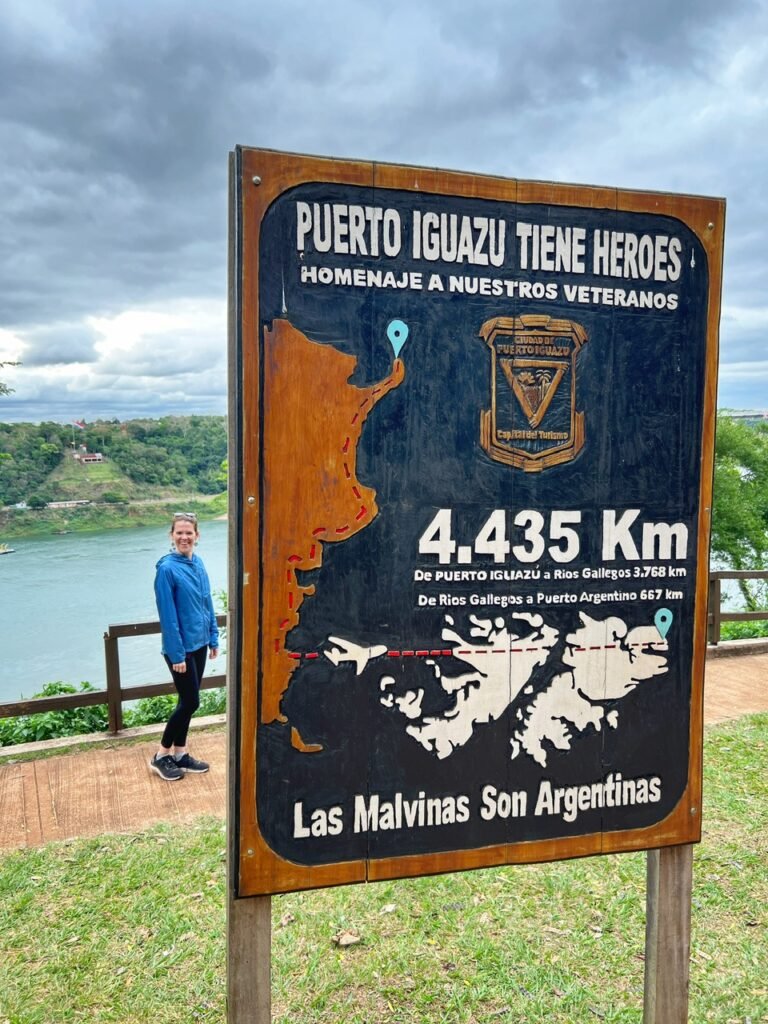
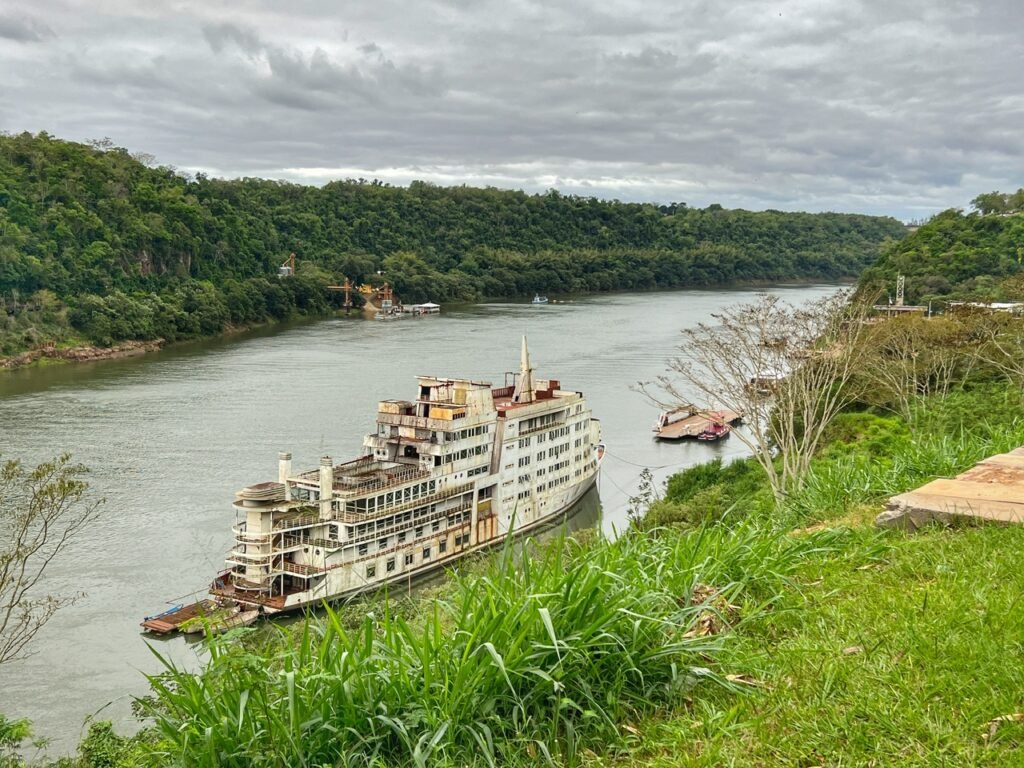
A plaque paying homage to the Argentinian veterans who fought Great Britain over the Malvinas Islands, as well as a dilapidated riverboat which was clearly once a showpiece so it was disappointing to see it in such a state of disrepair. It was fascinating to learn that tourism has been happening in the park since the 1890s. (Not that this boat is this old 😂)
Iguazu Day One: Argentina Side

A visit to Iguazú Falls has been on our list for years, so we knew we wanted to maximize the experience as much as possible with the recommended two full days on the Argentina side, one day on the Brazilian side, and the Gran Aventura boat experience where they toss you inside one of the falls.

The falls are made up of roughly 275 different vertical drops, with heights varying from 60 – 82 meters (200-270 feet). It knocks the socks off of Niagara making it taller and twice as wide.
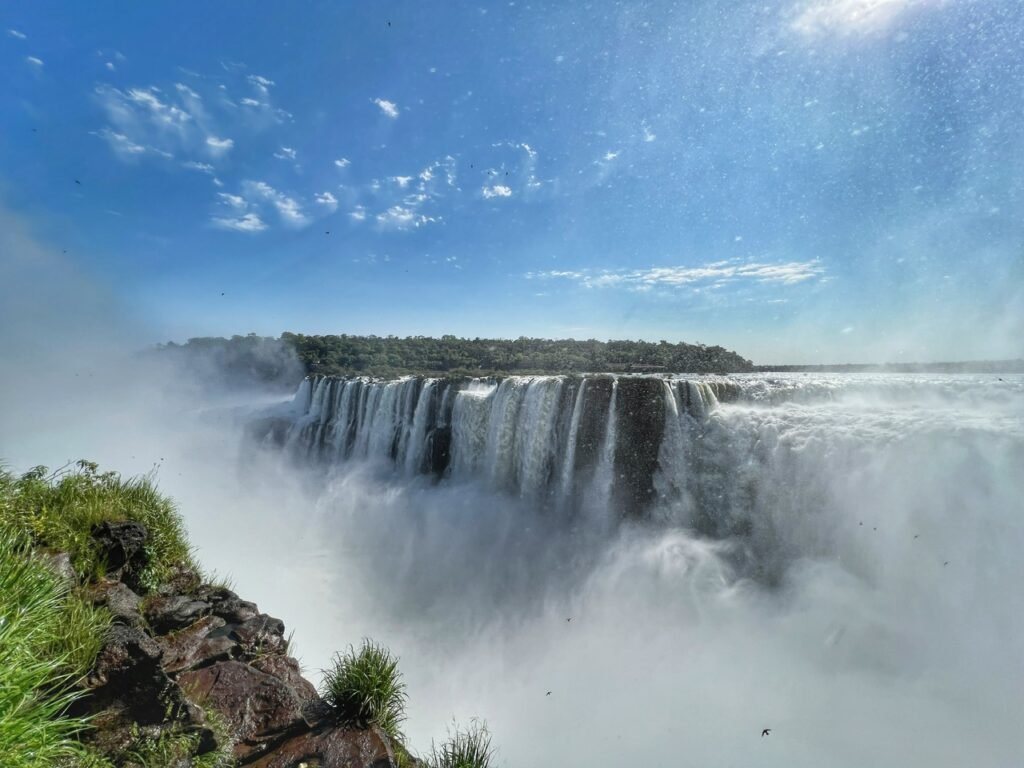

La Garganta del Diablo, or Devil’s Throat is one of our planet’s most powerful ecological trains. It can be seen from the Circuito Interior Trail.

So how did this day come to be? Well, we took one of the first buses around 7:15 am from the local bus station in Puerto Iguazú ($7.32/RT) to ensure that we arrived to the park by its opening at 8, which we highly recommend. We bought tickets for 10,000 pesos each ($13) using our Visa card. The second day was 1/2 off this rate. Also, note, we did not bring our passports. When you get in line there’s a sign that says you need them, but fortunately that wasn’t the case. 😅
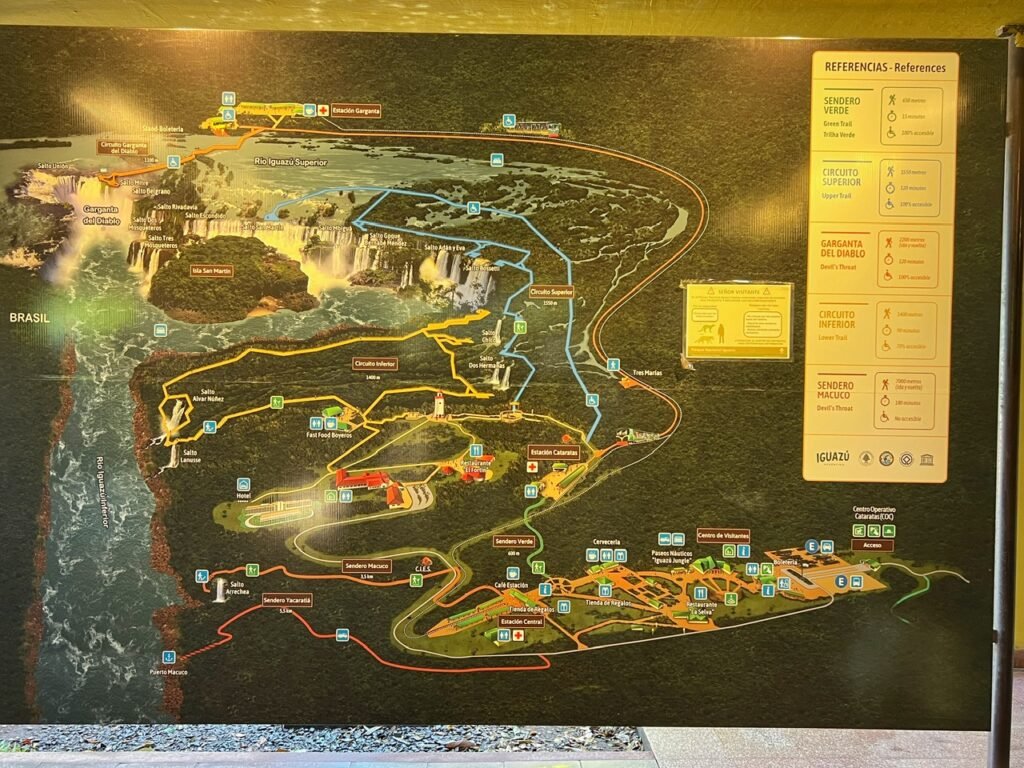
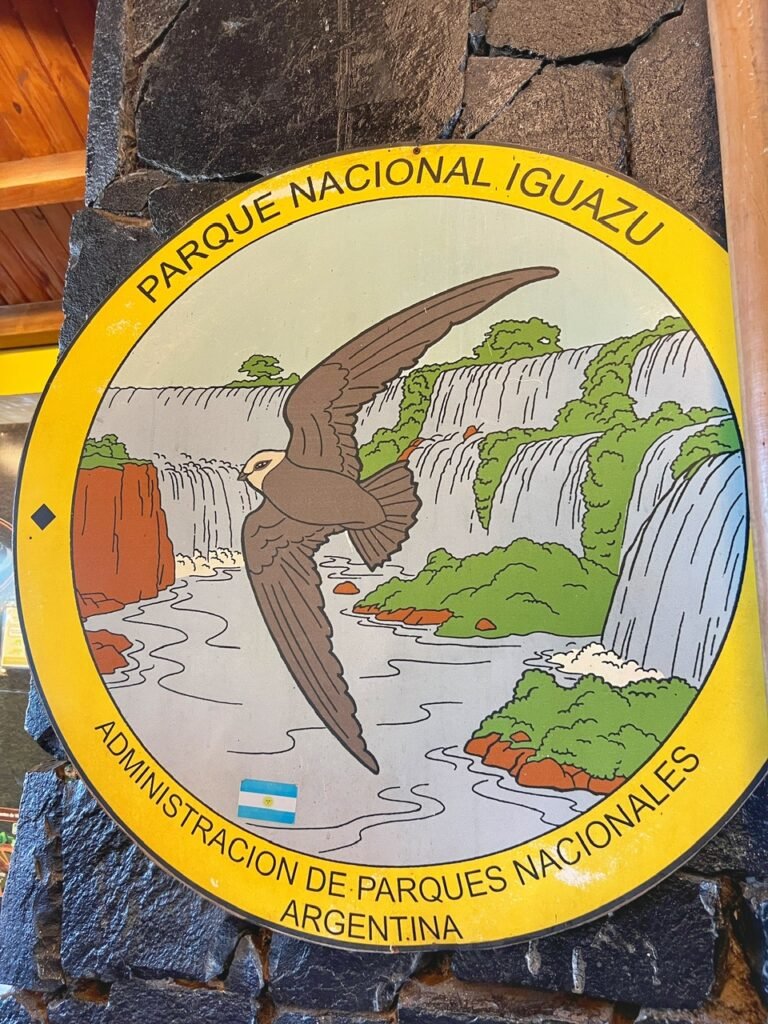
As you can see from the park map, the Argentina side is spread out and complex. The official seal. This national park was created in 1934 to take care of the subtropical jungle and the landscape beauty of the Iguazú Falls. The name Iguazú in Guarani (indigenous language) means “large waters.”
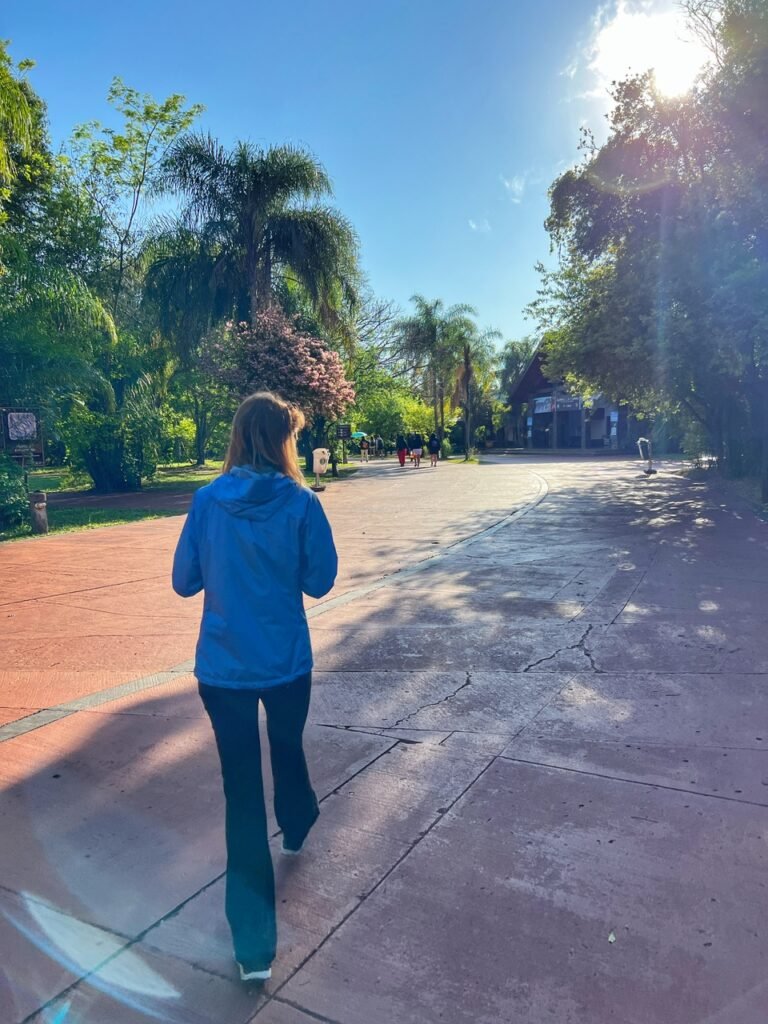

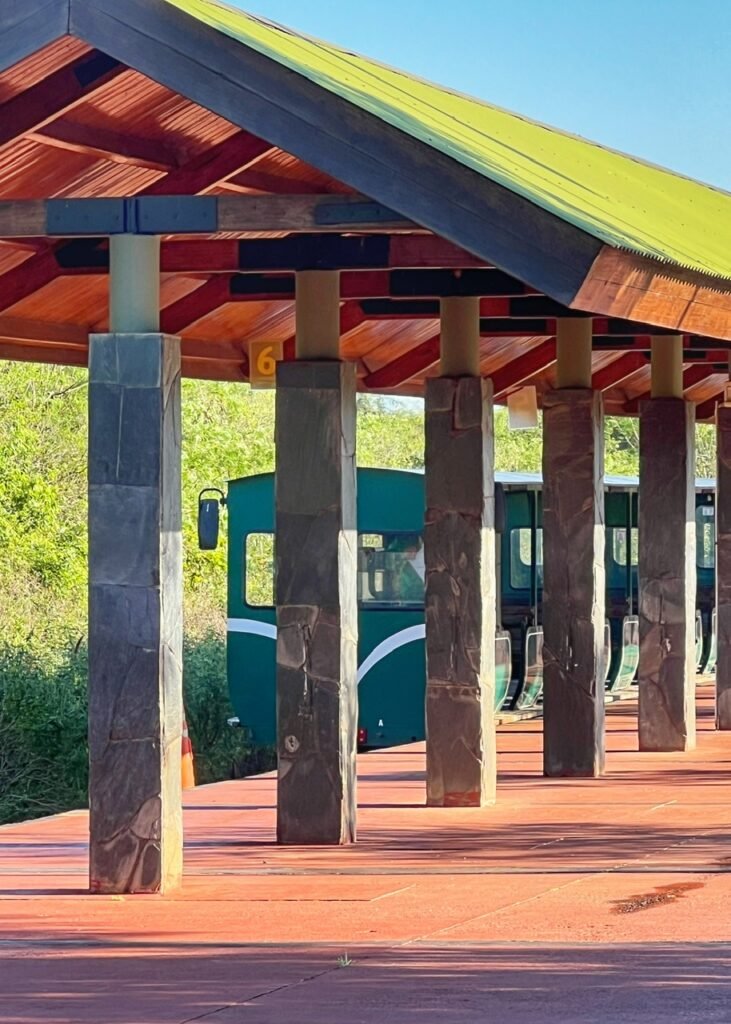
And for a few delicious short-lived moments in the early hours, it appears we had the park almost to ourselves. We didn’t. After they allowed us to enter, we knew we wanted to head directly to the park train (included) so we could get to Devil’s Throat before the throngs of name-tagged people following flashy umbrellas arrived. The adorable (and slightly hokey) train is assigned by time slot and car and the system was pretty organized. You also have the option to walk the trail the entire way to Devil’s Throat, but that takes a couple hours, which of course was not an option to save our sanity.
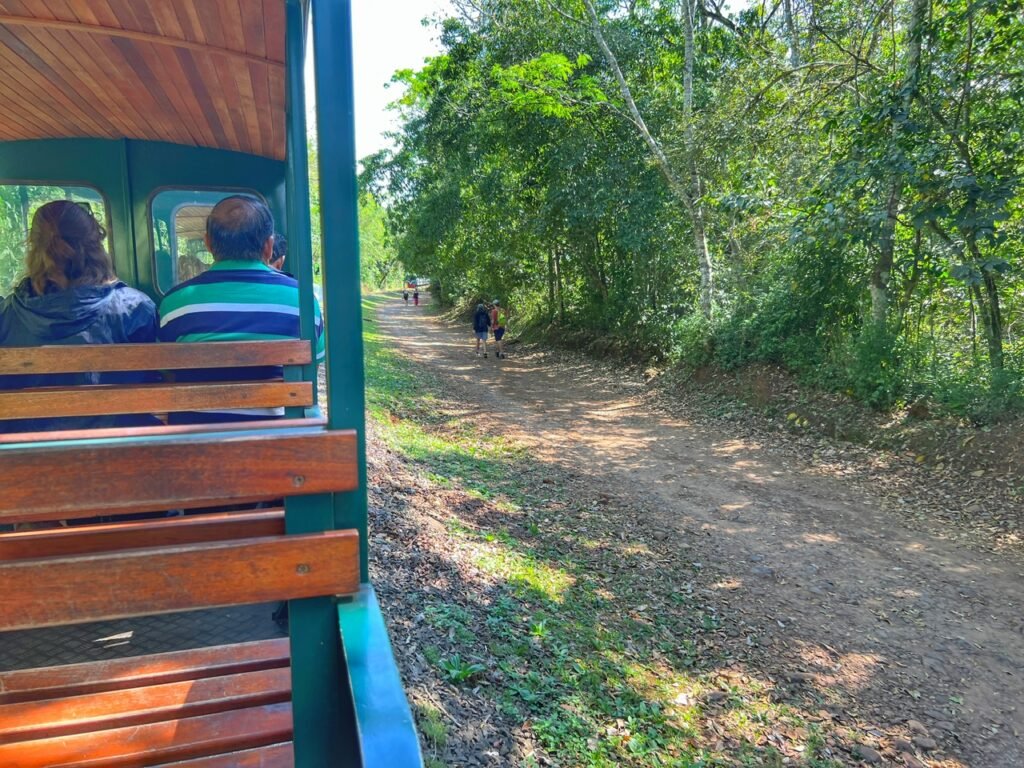
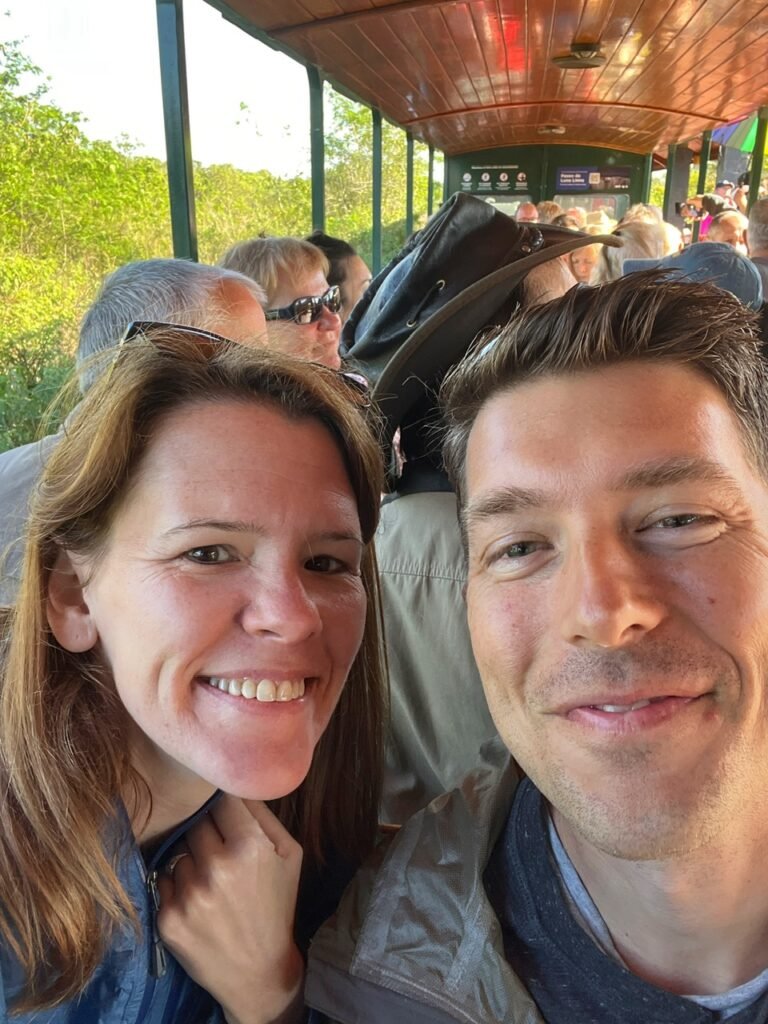
There was a cluster of German tourists on that first train with us, which confirmed we were doing it the most efficient way possible. We were advised to avoid Devil’s Throat between 10-3 at all costs.

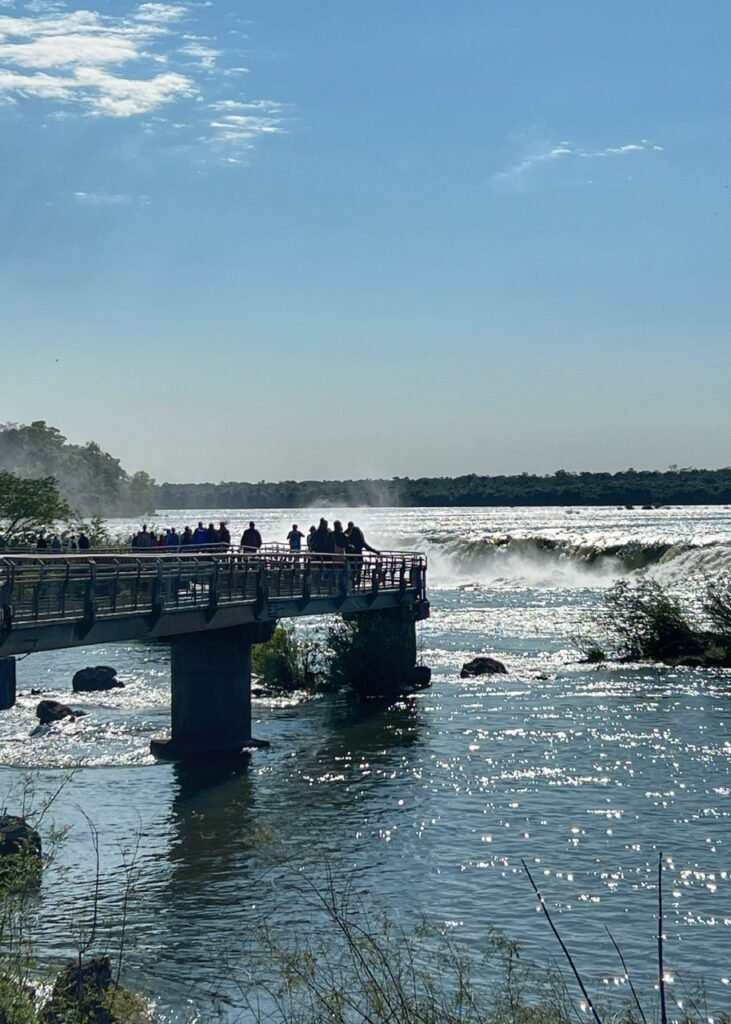
We had arrived!! Although we’re not usually the types to rush through experiences, this was the time to book it. Because as you can imagine, the 1 meter wide and 1.1 kilometer long gang planks over the river have potential to turn into quite a clogged Conga line. But getting there on the first train, we knew we were surrounded with like-minded people.
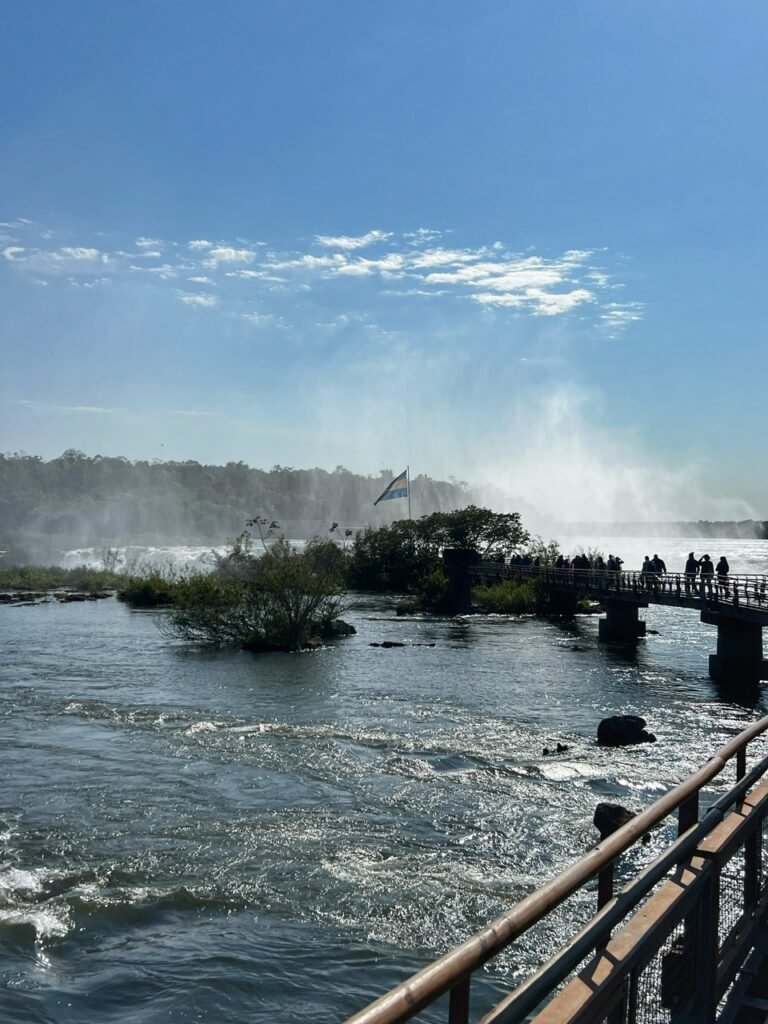


Approaching the spray brought an unbelievably feeling of excitement! The placid Rio Iguazu got a little excited too as we began to see its waters churning up for a helluva ride.
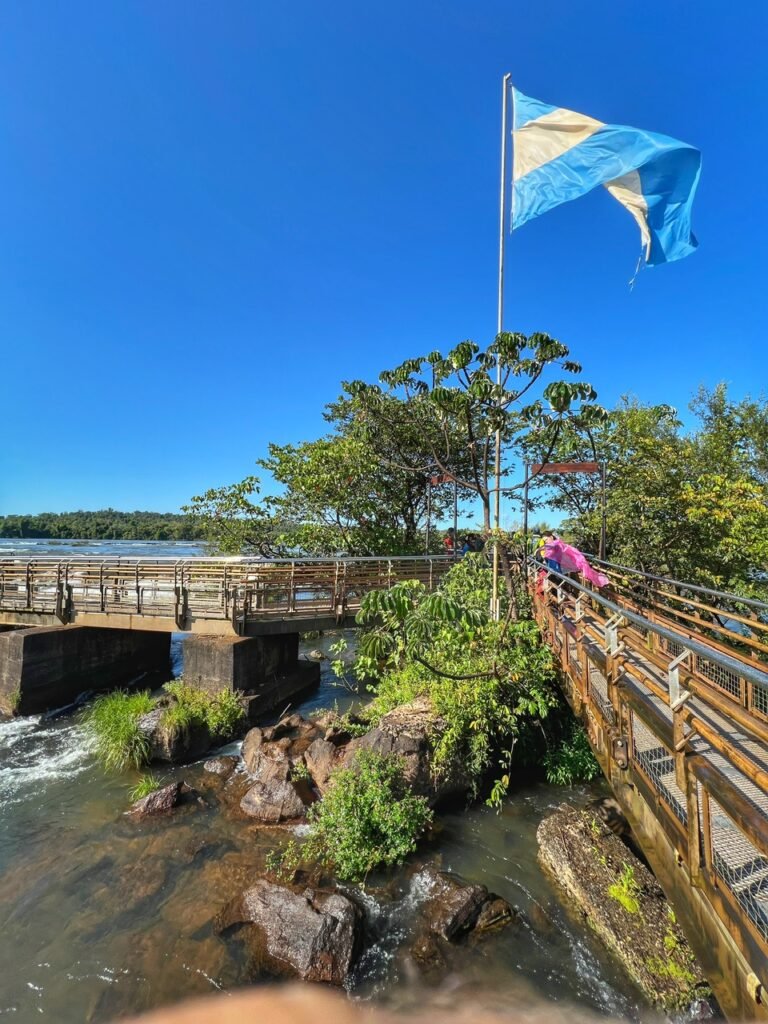

Walking out into the planks perched over this roaring natural phenomenon, Mandy at last minute decided to put on a $1 poncho we’d bought for the Quilotoa Loop hike earlier this year and never used. (Because everything’s always a dollar in Ecuador). Naturally it immediately ripped three buttons, and was completely worthless other than making her radiate a luminous and catchy shade of neon.

But ohhh….that view!!
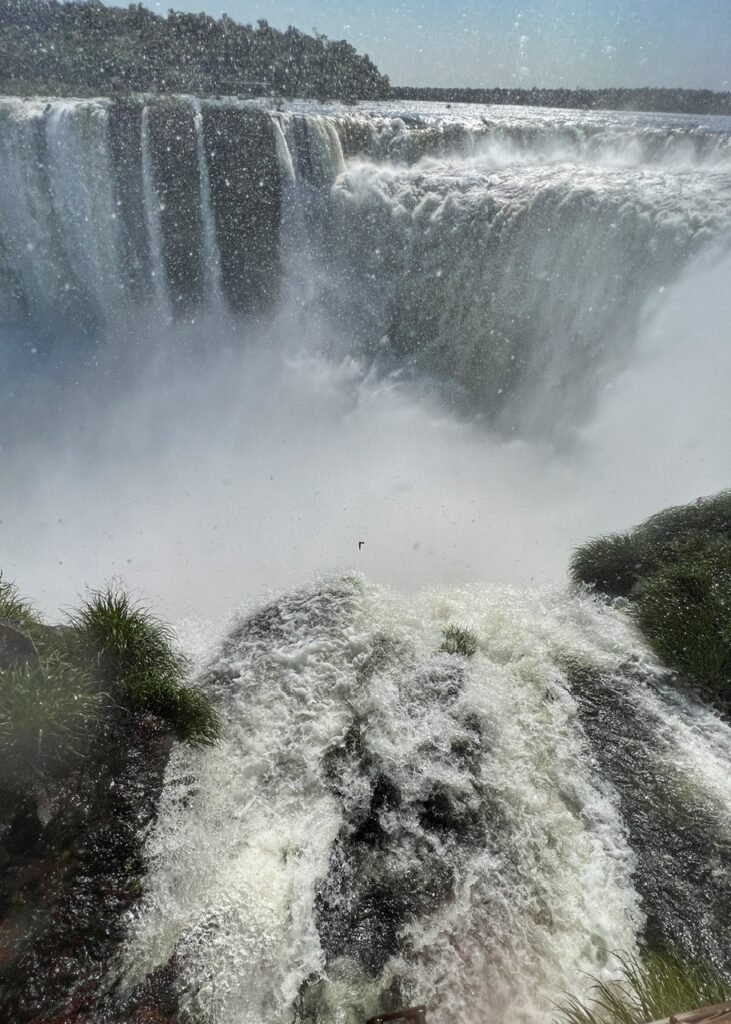

As you peer over, droplets flying in your contacts, it’s best to simply close them and appreciate the sound of the deafening cascade plunging to an unknown destination below. And we were so grateful for the gorgeous skies we had that morning. It is truly one of the most majestic natural wonders we’ve ever seen. (Probably why it’s on the list for top natural wonders in the world.)
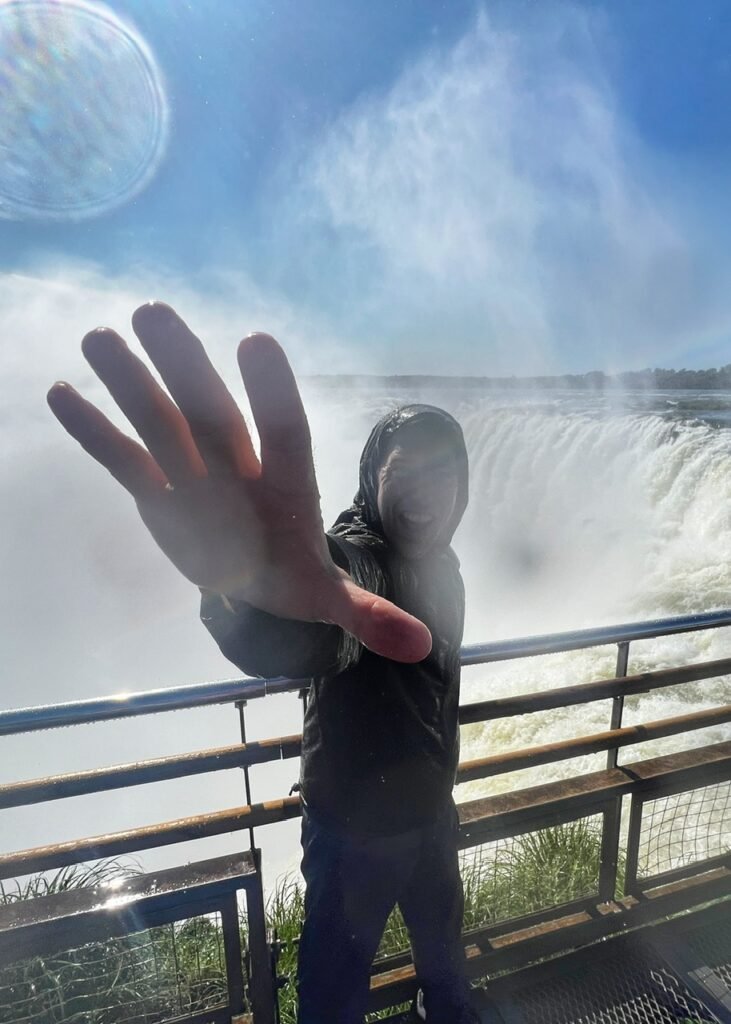

That said, it’s a wee bit challenging to take good photos here because the water is constantly plastering your camera lenses with a fresh sheet of H2O. And the stupid phone protecting case we’ve been carrying around for a year was more functional in Mandy from the technicolor dream coat’s hand that around our semi-waterproof phone.
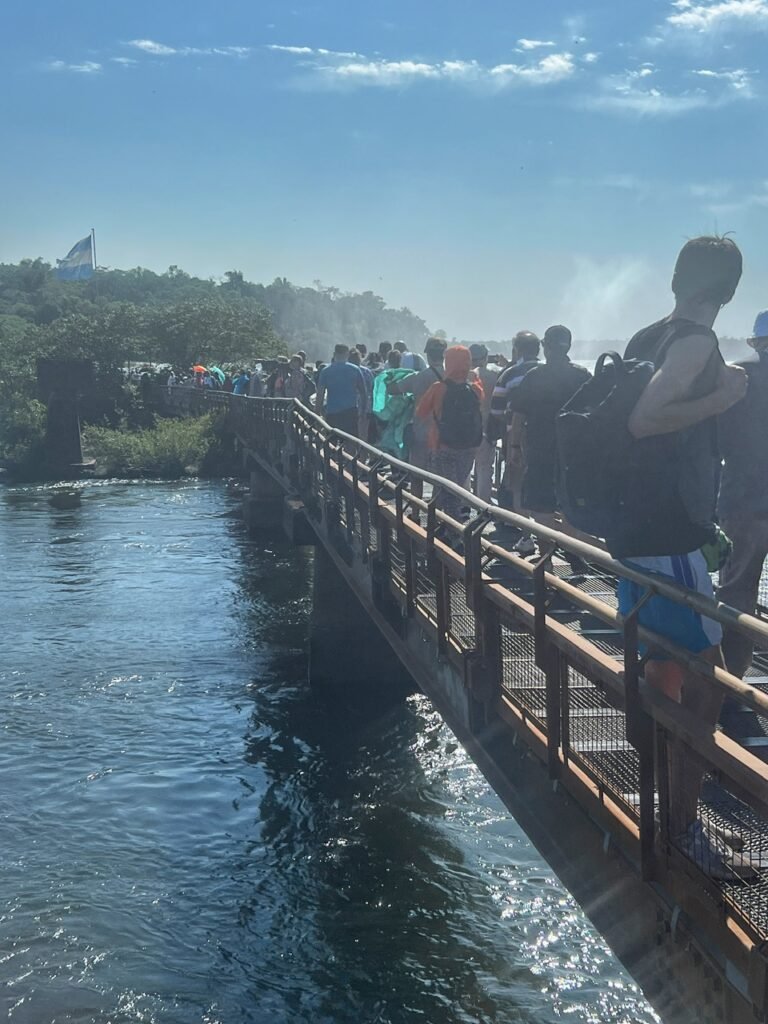


When we left, it was already getting very clogged. But we definitely got to appreciate the walk back over the river much more, and even had it by ourselves for a bit!
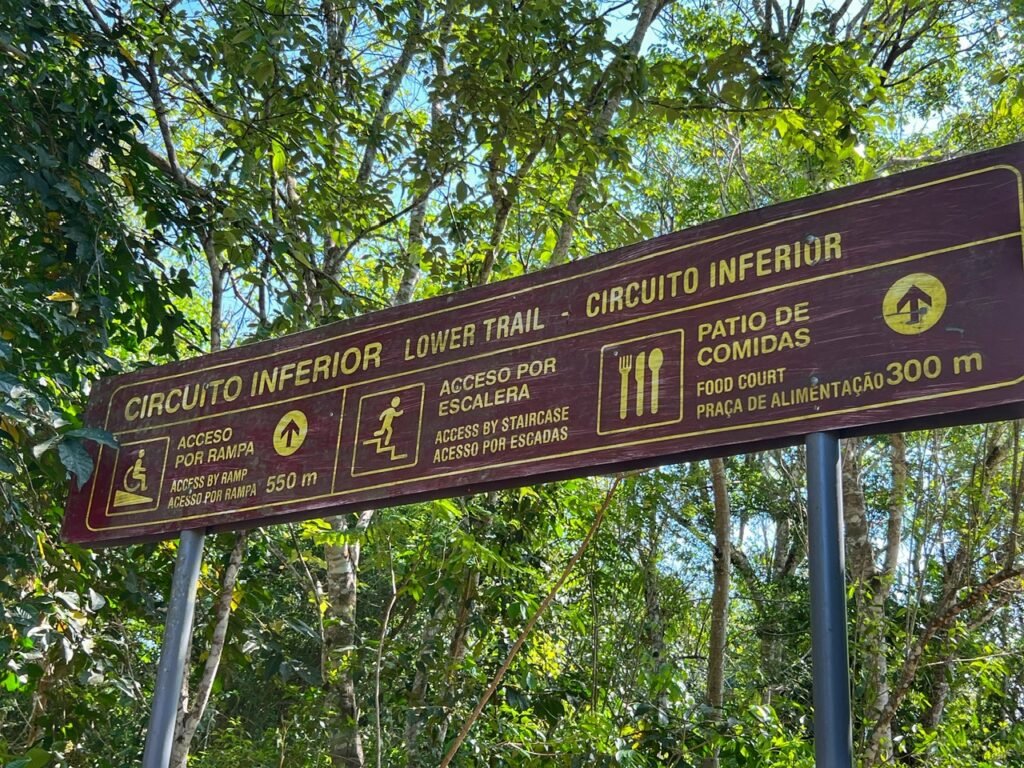

Next we took the train to the middle station to head to the first of two waterfall trails, called Circuito Inferior, or lower trail. (1.4k) We were immediately entranced by the jungle, as well as empty walkways, which lasted about five minutes.

The first sighting of Devil’s Throat from a very different angle. (Not sure what our obsession was with the flailing arm photos that day, by the way.)
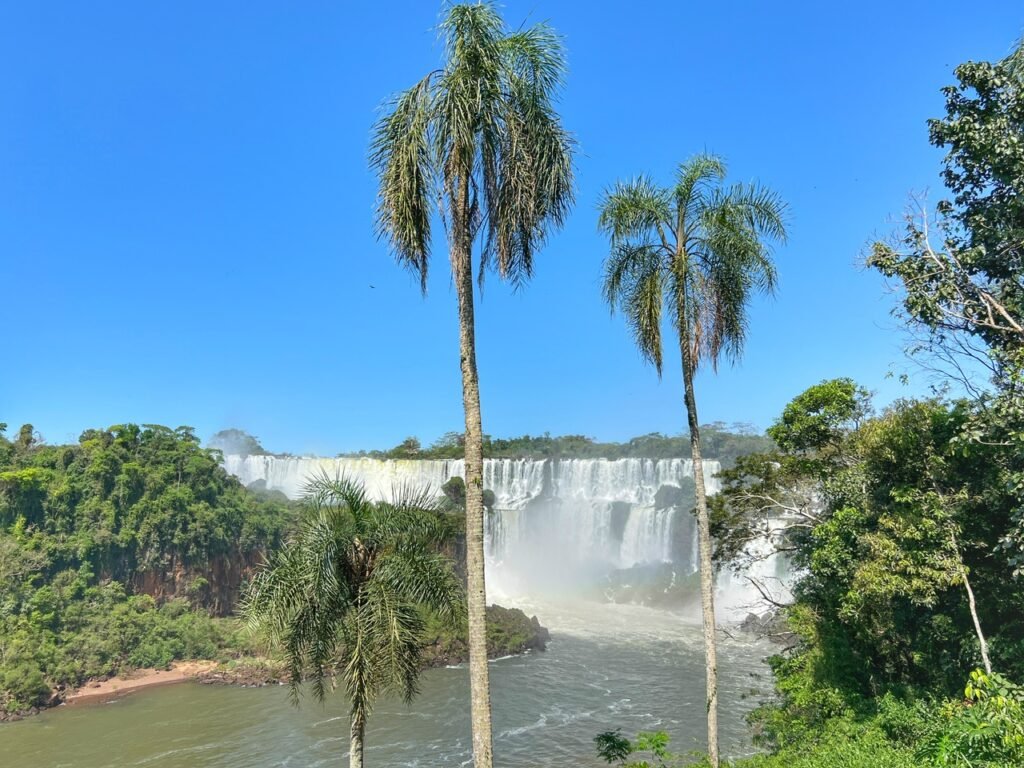
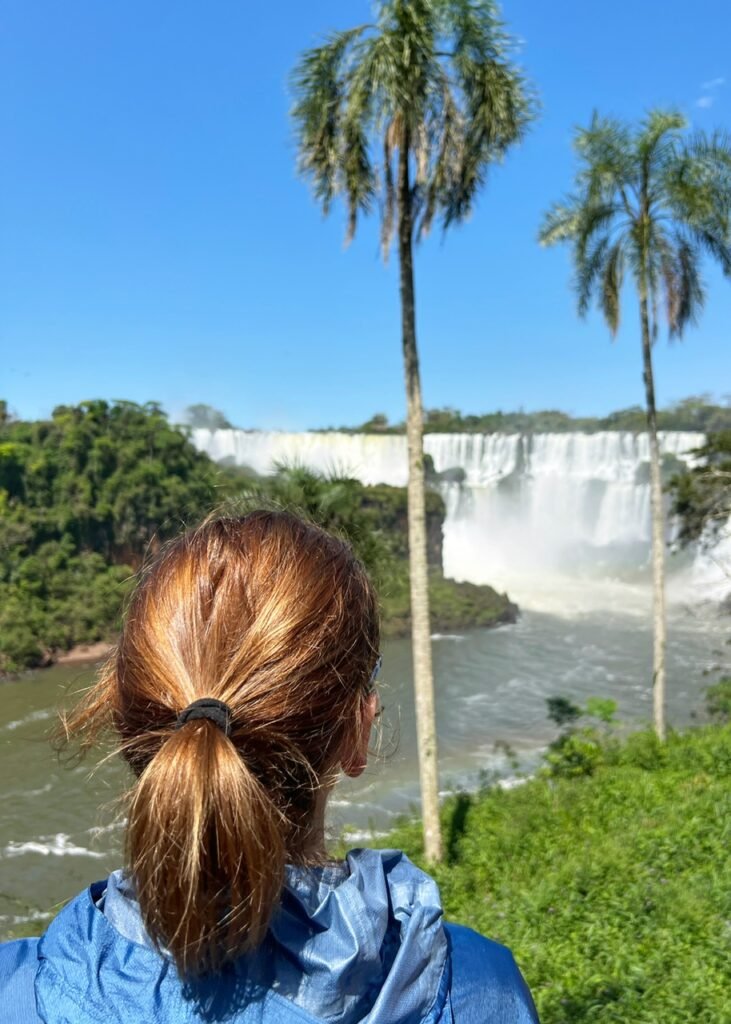
And then you turn the first corner and see this. Wow. Just insanely beautiful. We definitely gawked at it for awhile.

And moving on, started noticing the “adventure” boats down below, which was on the agenda for the following day because we were clearly gonna need a closer look under the hood.

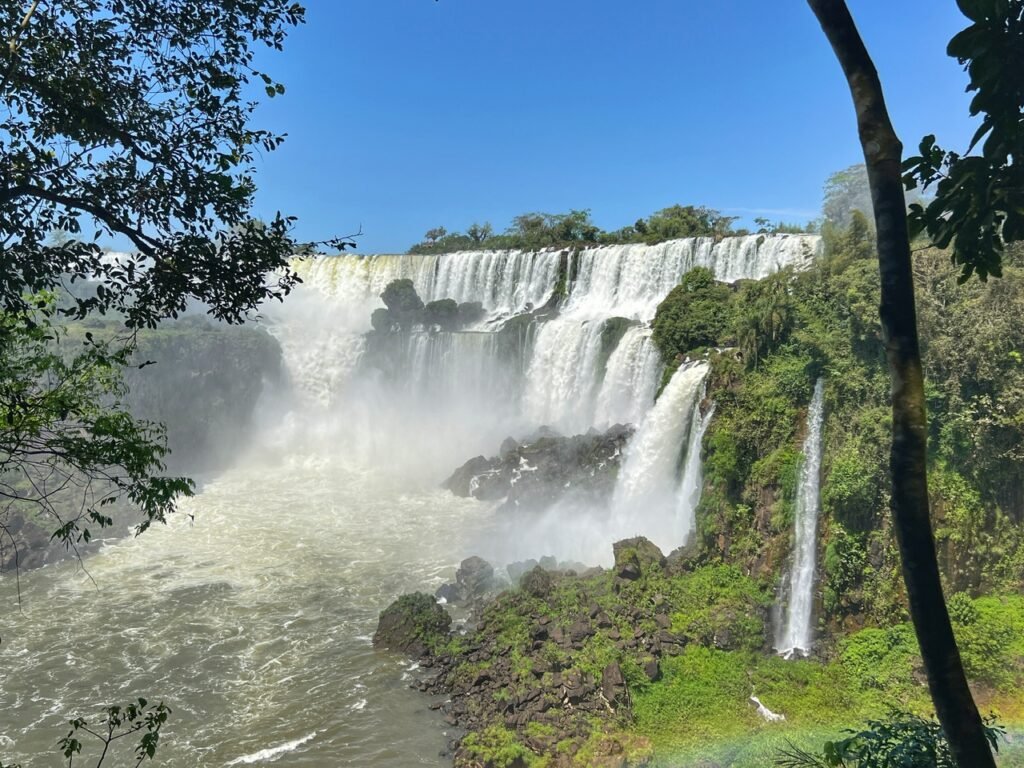
And just when we thought it couldn’t get any better….
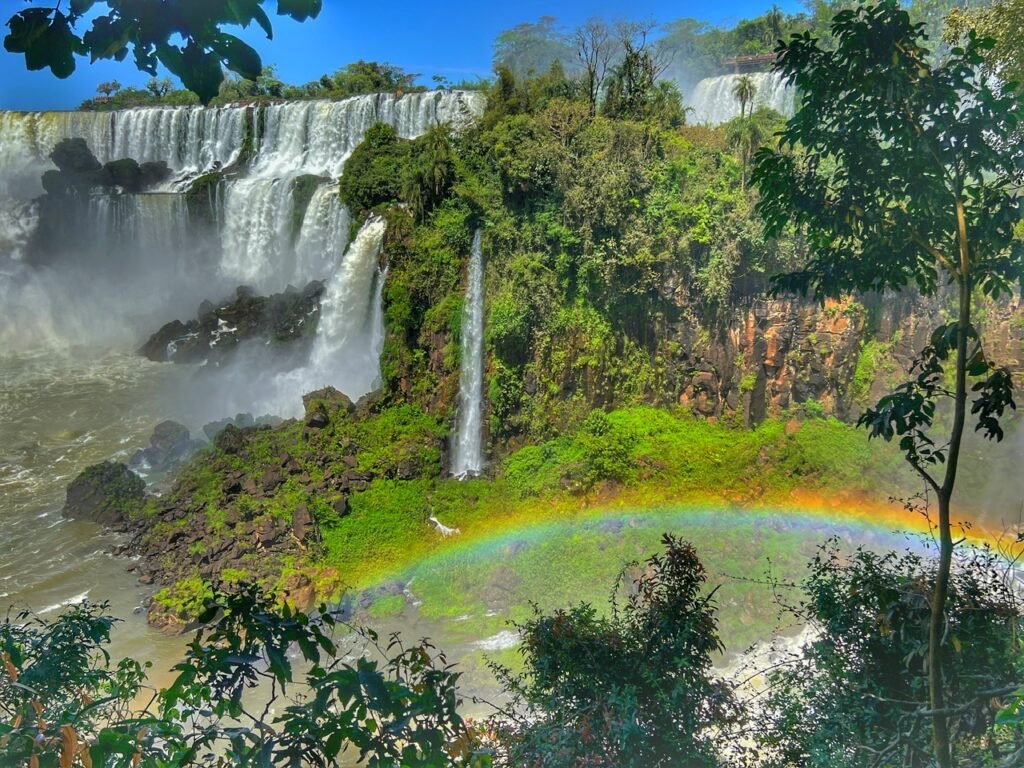
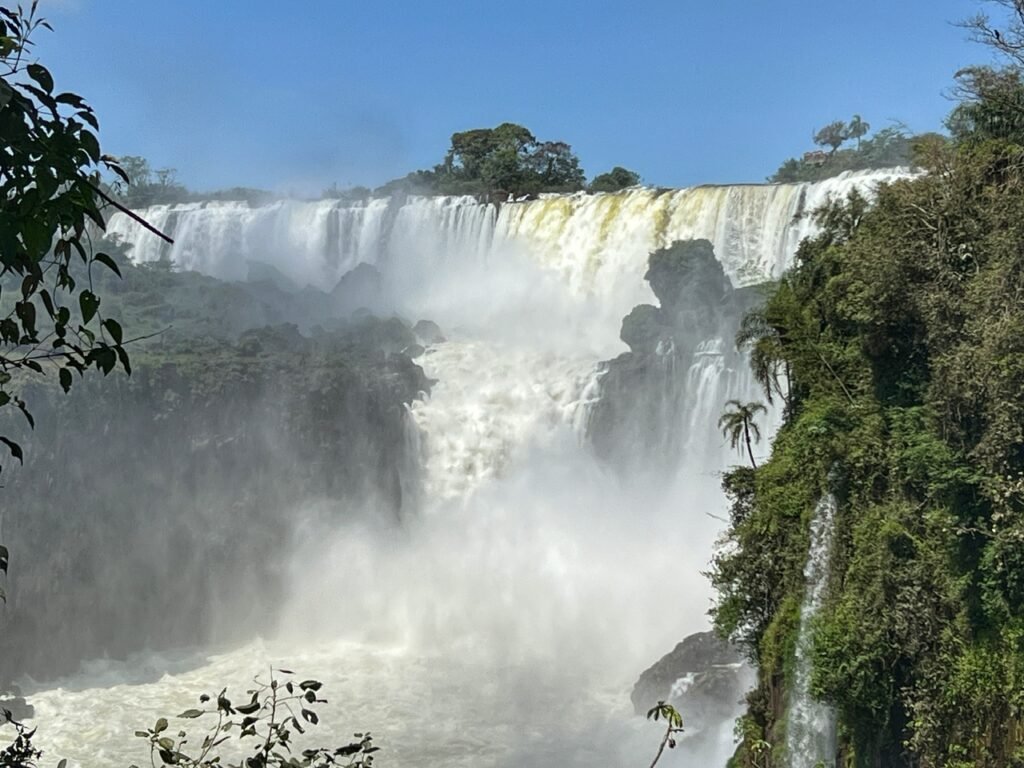
…the universe dropped the icing on the cake in our laps.
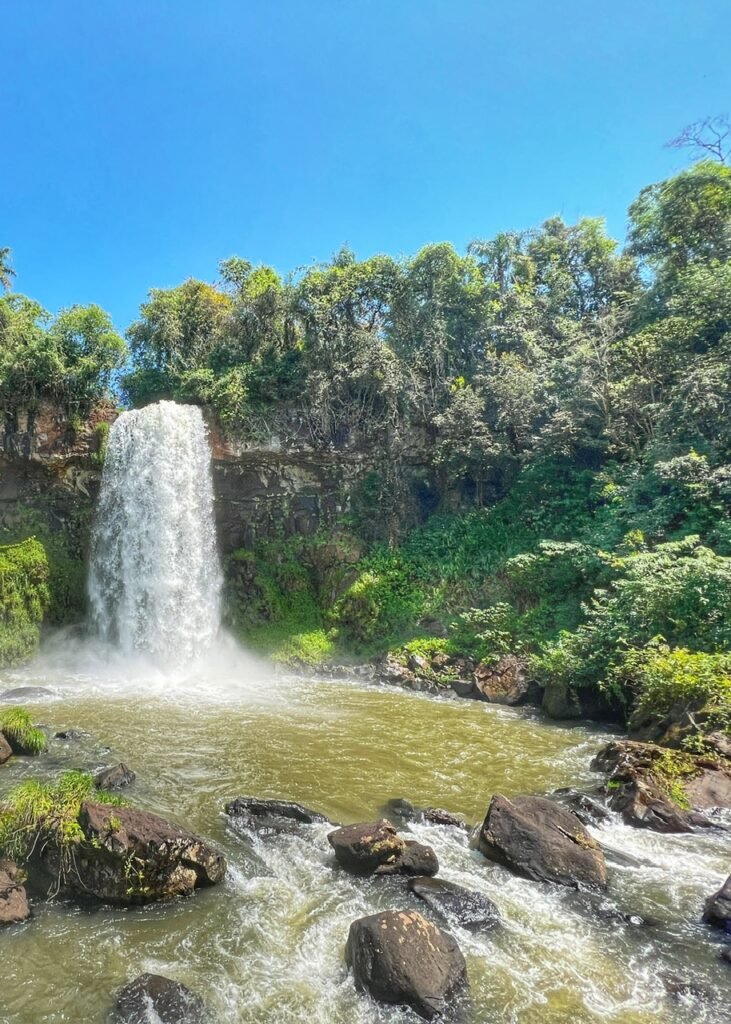
Oh geez. And then we walked upon a normal Oregon sized waterfall. Not sure any waterfall will compete from this day forward. Victoria here we come! At this point, we ate our picnic and then headed to the upper trail or Circuito Superior where you get to walk on top of the falls…
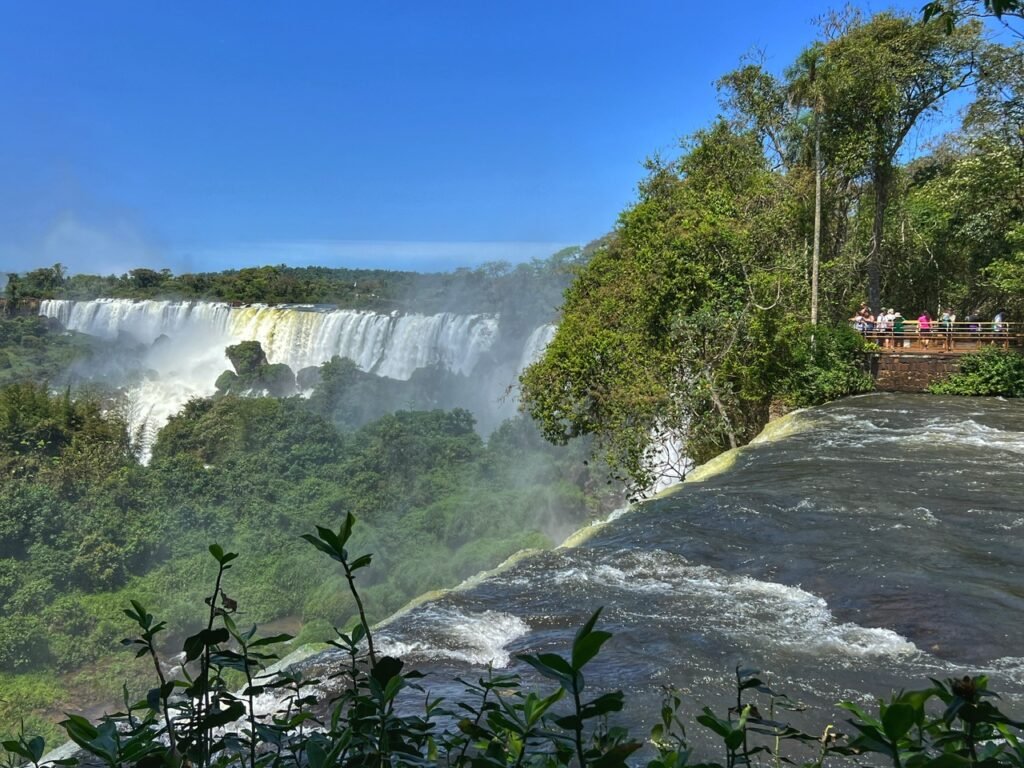
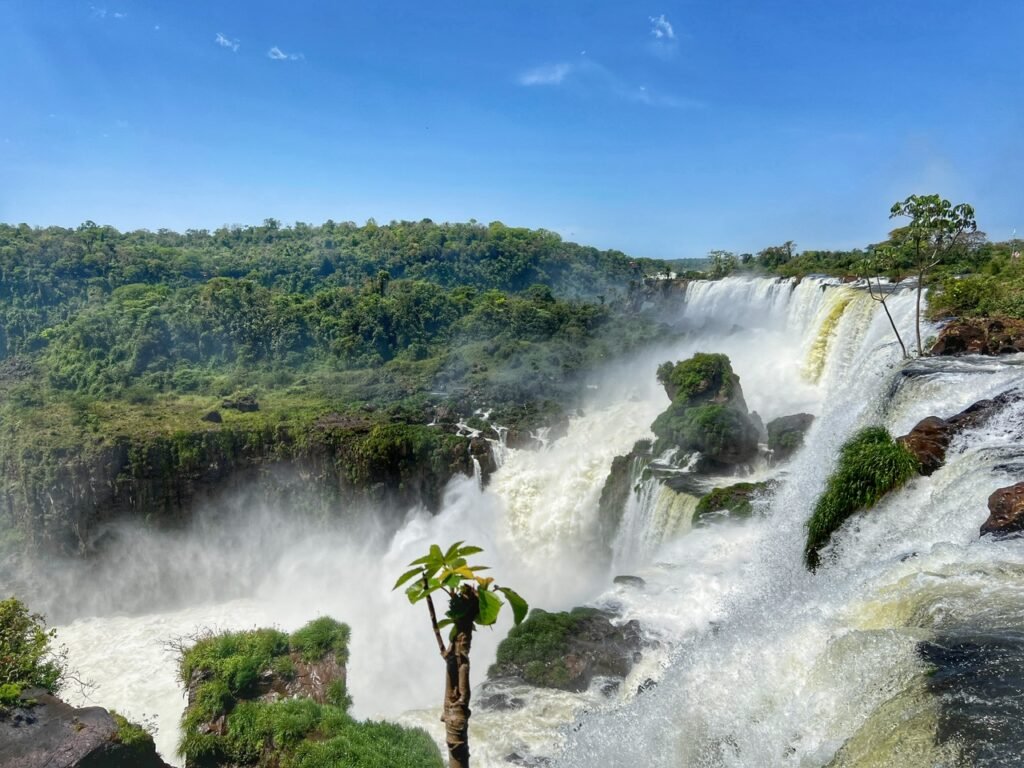
…for a very different vantage point.
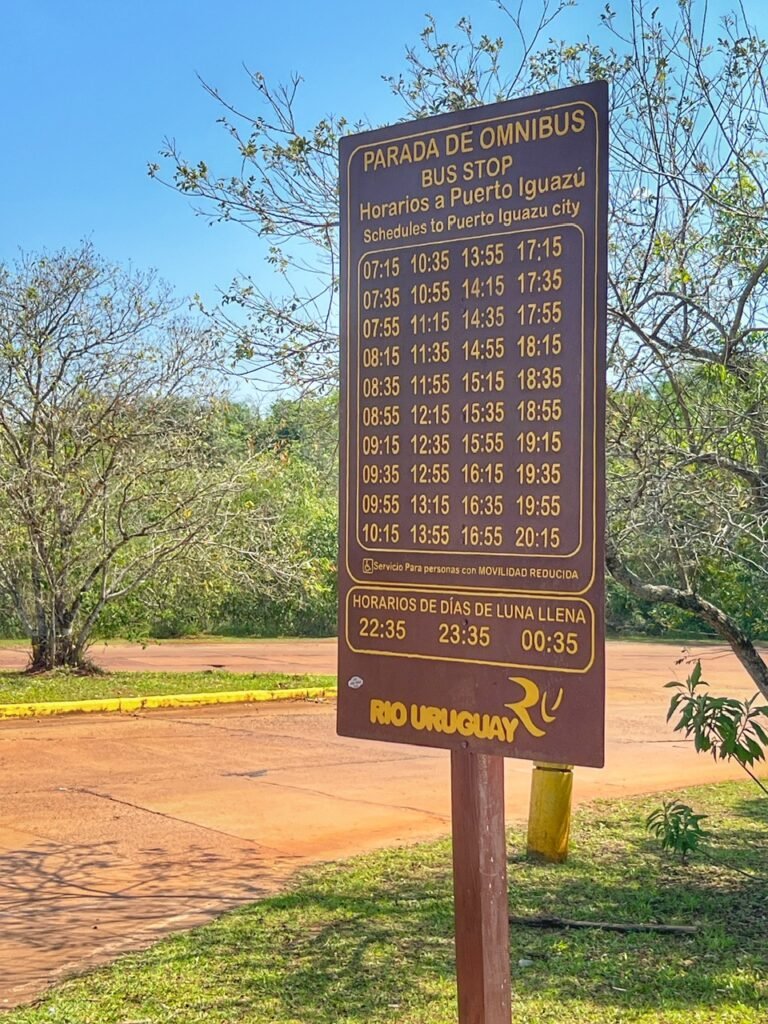
After we’d done both of the main trails, it was about 2:00 so we called it a day, hopping on any of the local buses heading back to Puerto Iguazú.
Igauzu Day Two: Argentina Side
When we met our friends, Brian* & CC in Rio de Janiero, they advised to us to absolutely not miss an up close and personal view of the falls on the Gran Adventura boat ride when we went to Iguazú. Turns out, they were right. It was completely worth the splurge, the submerge and the highlight of our days at the parks.
*Brian, our idol, the 38-year-old teacher that’s been to all 196 UN recognized countries, so yes, we were gonna do anything he told us to.
We bought our tickets online through Iguazu Jungle tours the day before our adventure because they had already sold out for the first day of our visit to the park. They cost 27,000 pesos or about $39/each. If you missed our bird’s eye view from the day before, the day was a lot different than we were granted with on game day. But who really cared?! The intent was to get pounded by Pachamama. (Mother Earth.)

After checking in an hour early and exchanging out web tickets for official tickets, we boarded a hefty all-terrain vehicle which looked like it was bounded for a safari and chugged about 30 minutes through some decently lush jungle where we saw three of the five toucan species in the park.
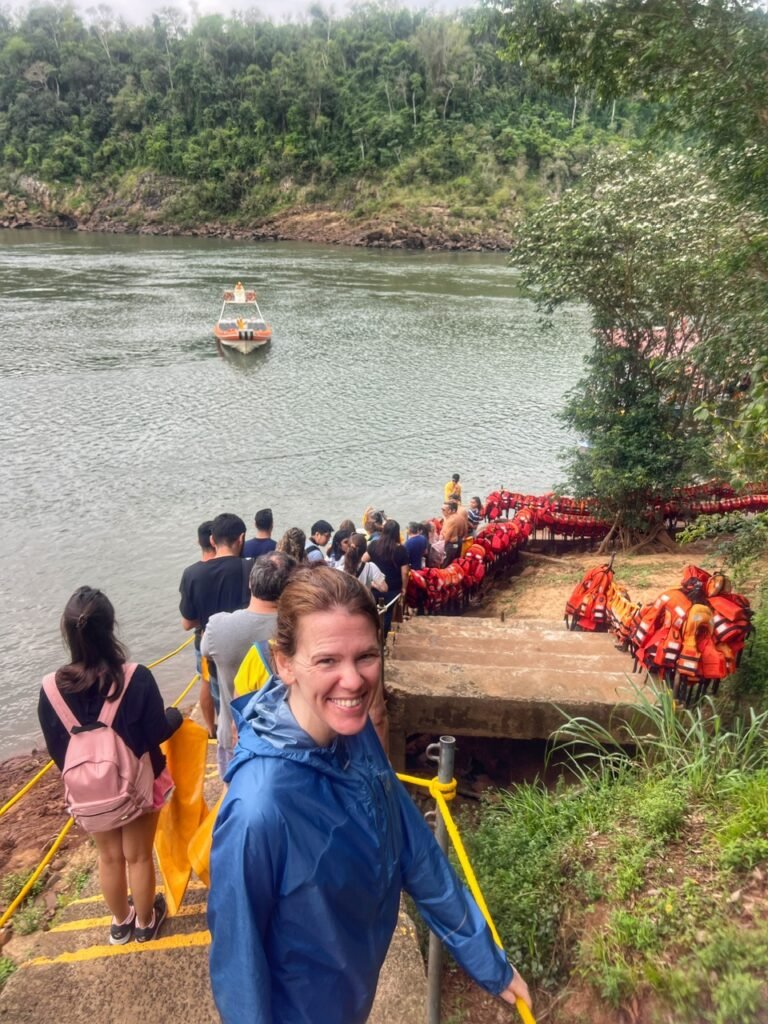

At last we arrived to the boat dock. They gave us giant dry bags to keep our small backpack dry, as well as our shoes and fitted us with the most robust life jackets we’ve ever seen. The floaty bricks crammed inside had to be at least 6 inches wide. Indeed, that should save us from the forces of nature should we tumble in. We then got our safety instructions in rapid fire Argentinian Spanish.
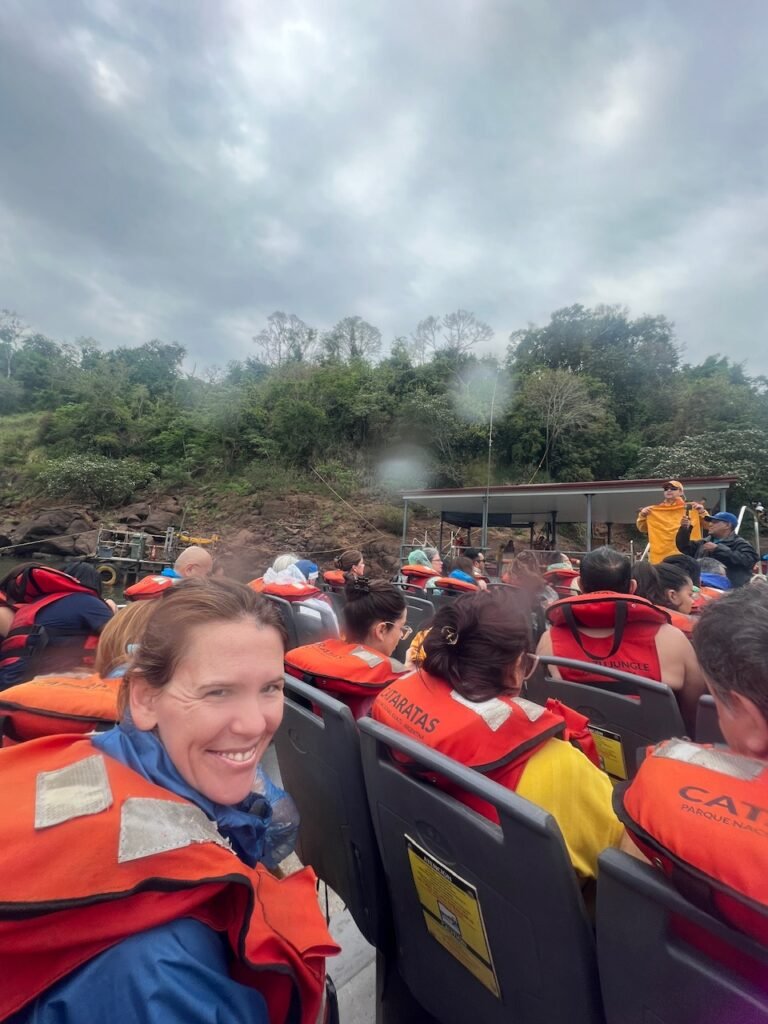

Ummm…Sure…we got it! Entiendo bien señor! Vamonos!!! We headed down the placid Iguazú river in the slightly chilly air to get the party started.

Our first glimpse of the falls we had seen yesterday, as well as Devil’s Throat.
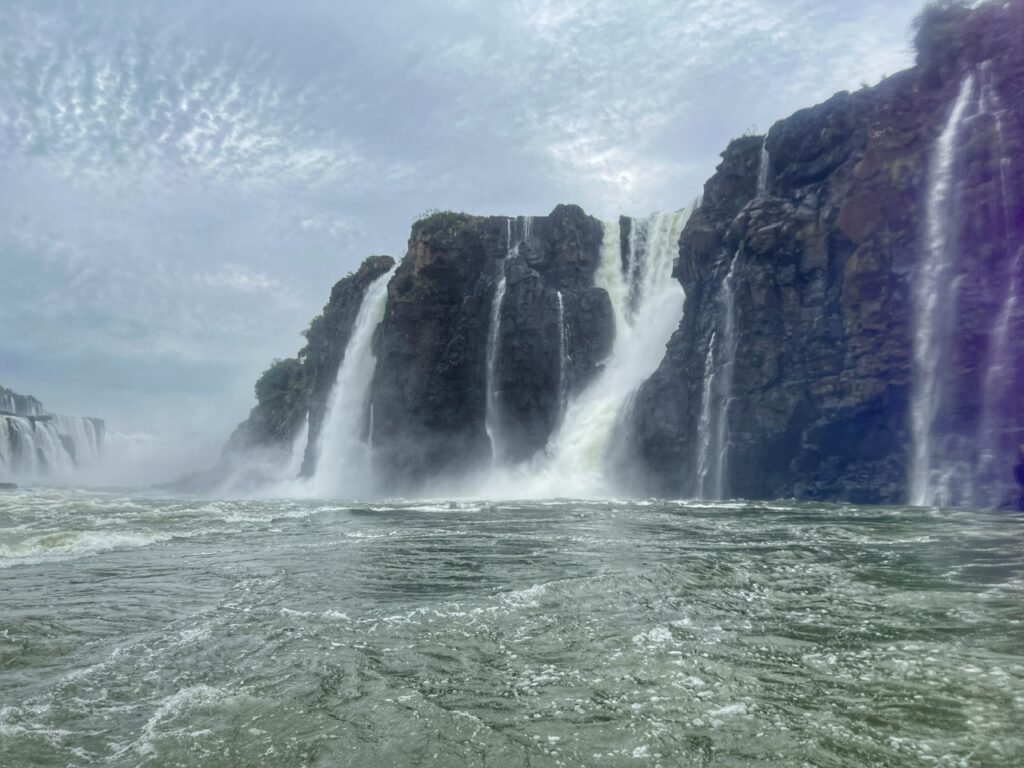
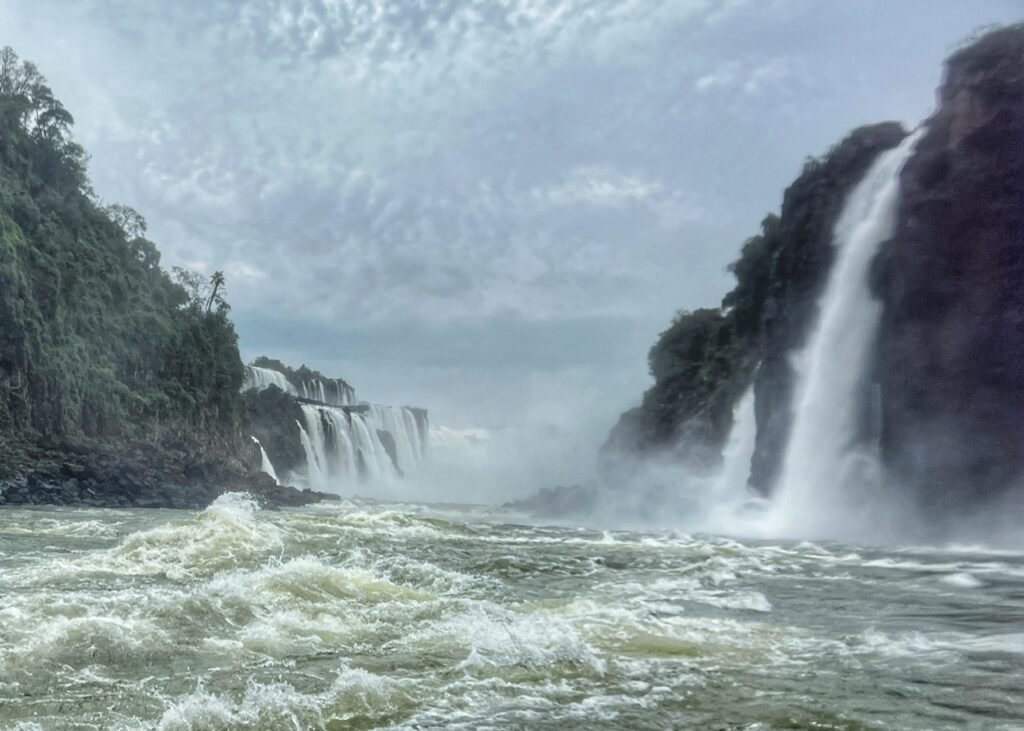
Uh, indeed. Pretty sure if we drift down that way it’s a straight ticket to hell. In reality, it’s actually the first falls on the right that we got completely deluged with.

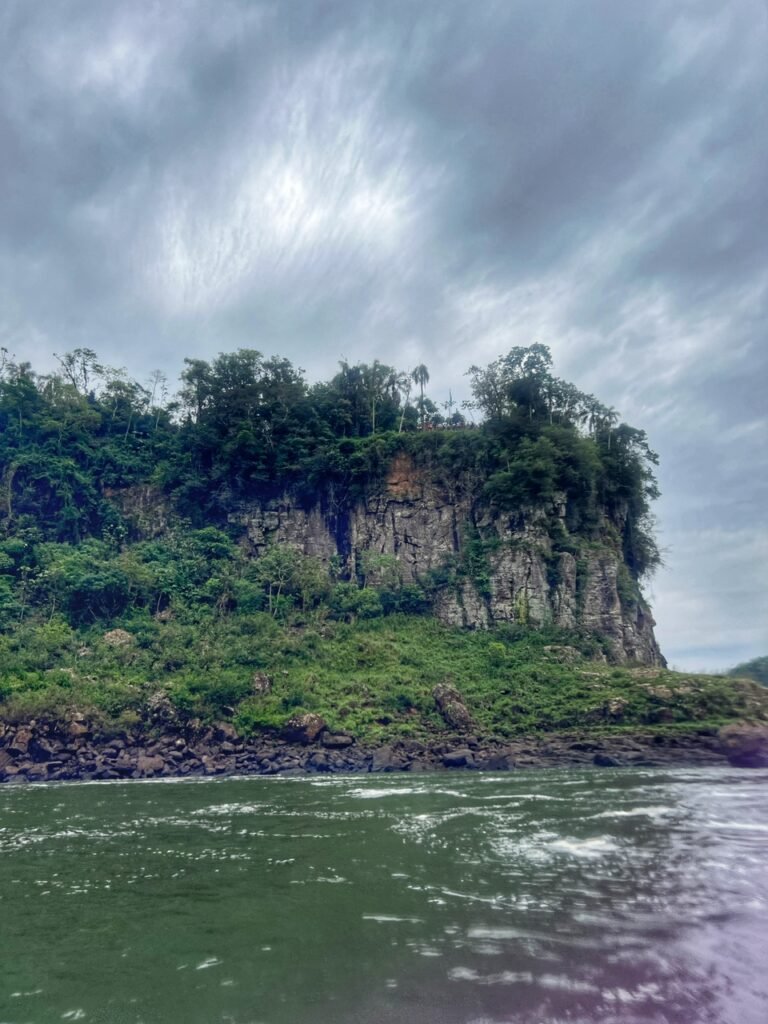
Prepping for the drenching as we gazed up at the cliff we had stood above the day before. Now, we were the schmucks on the boat. But, alas, glad it was a cloudy and cool day for the occasion! 🥶 🥶 🥶

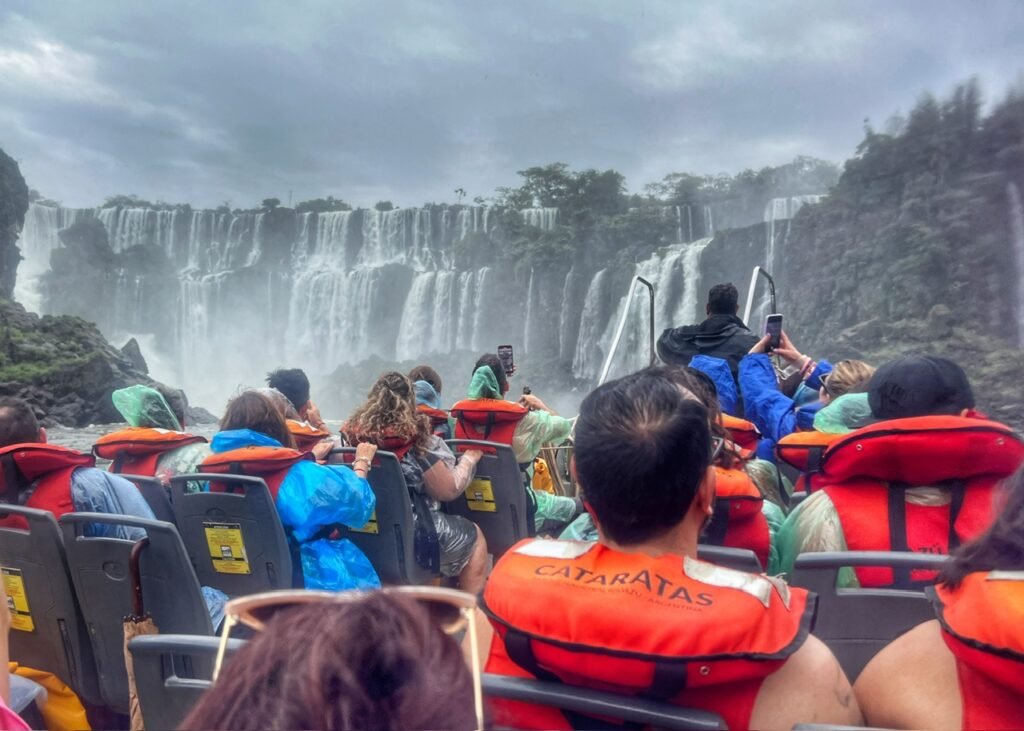

And as we maneuvered closer…and closer…and closer.

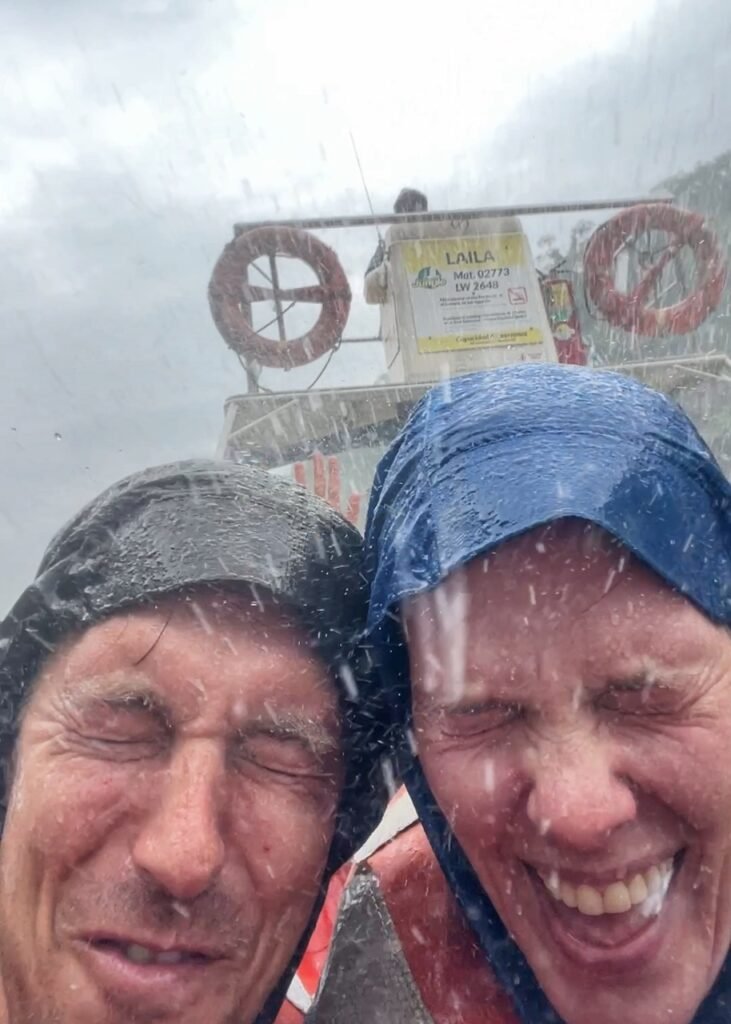
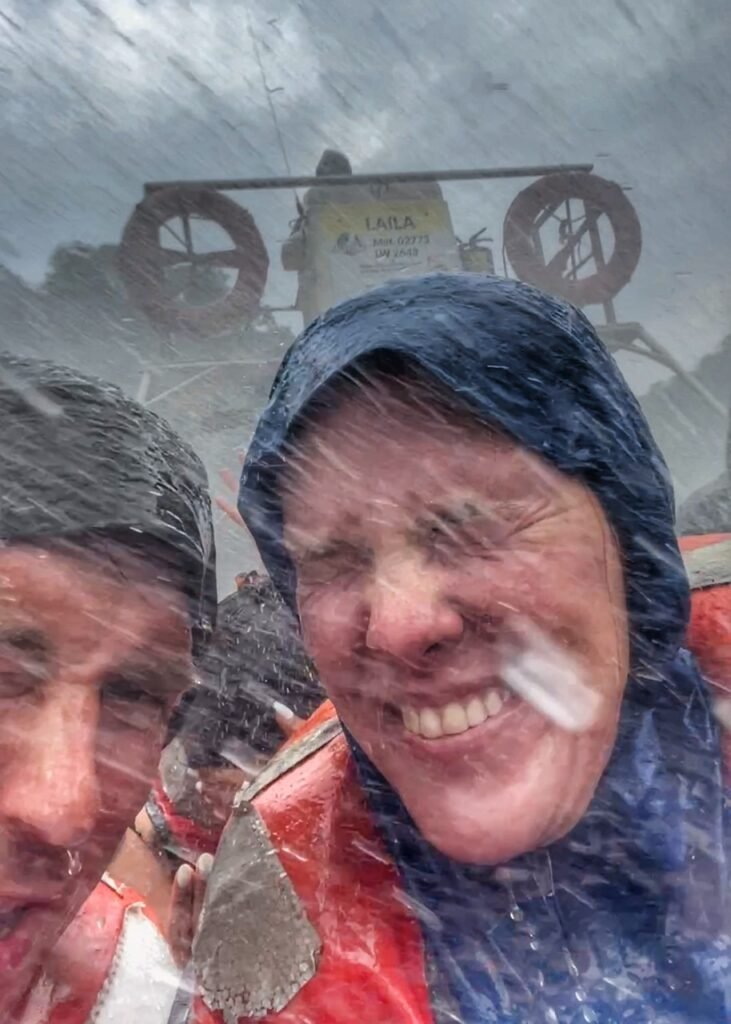
The driver gunned it and tossed us directly in the biggest hydro-engine of them all. And here we are, getting creamed by Iguazu.
Wildlife in Iguazu Falls

In addition to the gorgeous falls, Iguazu is a wonderland of wildlife and lush jungle nature, which becomes all the more copious as you meander away from the major tourist sections. This on its own makes it worth spending an extra day in the park.
We especially enjoyed the 7 km long Macuco Trail which was all flat and packed with capuchins, colorful polka dotted butterflies, and even a coral snake, which Greg nearly stepped on. It was a close call and we didn’t get a photo unfortunately, but it looked suspiciously venomous with red, white and yellow striped markings. (And of course, at the time we couldn’t remember the stupid mnemonic device about how to know if it was a “safe” one or not.)
Among the park’s rich biodiversity, there are 2000 species of plants, 400 species of birds and possibly as many as 80 mammals, as well as countless invertebrate species.
We’re quickly learning that the Black Capuchin is one of the most widespread primates in South America and their presence at Iguazu was no exception. While you’ll unlikely see them on the main waterfall trails, these frolicking mischief makers were everywhere on the Macuco Trail and they were NOT afraid of humans. Clearly someone has been feeding them! A big no no!
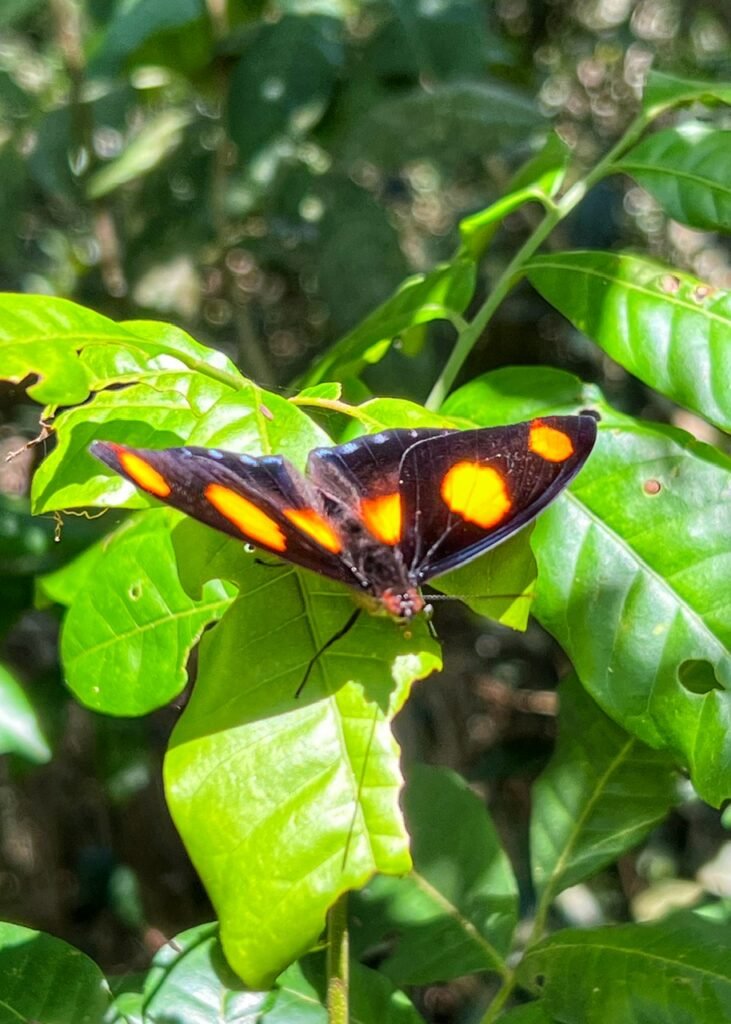
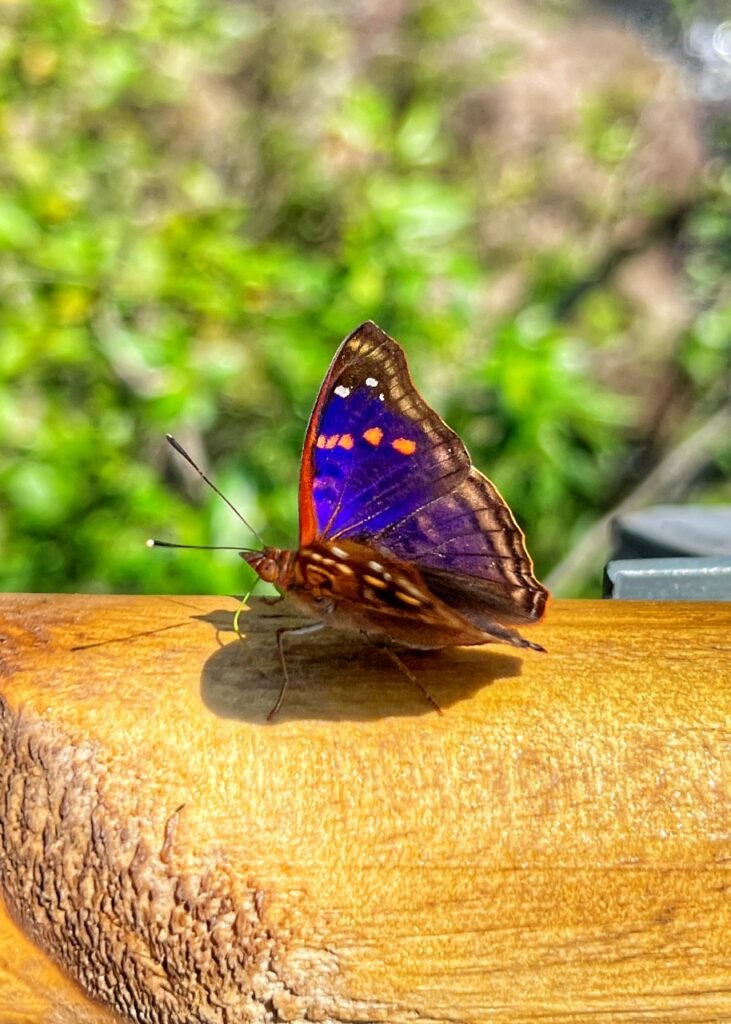
It’s pretty amazing to go to a place that claims there are innumerable species of insects…some of them which aren’t even identified. Especially when it includes butterflies which flitted about everywhere. Alongside the Blue-frosted Banner butterfly (say that three times fast!) you’ll find at least 699 other species, including the brilliant butterfly superstar, the blue morphus. The Agathina Emperor a species of butterfly of the family Nymphalidae. It is found in the Guyanas, Brazil, and the Amazon region. It is also called the purple emperor.
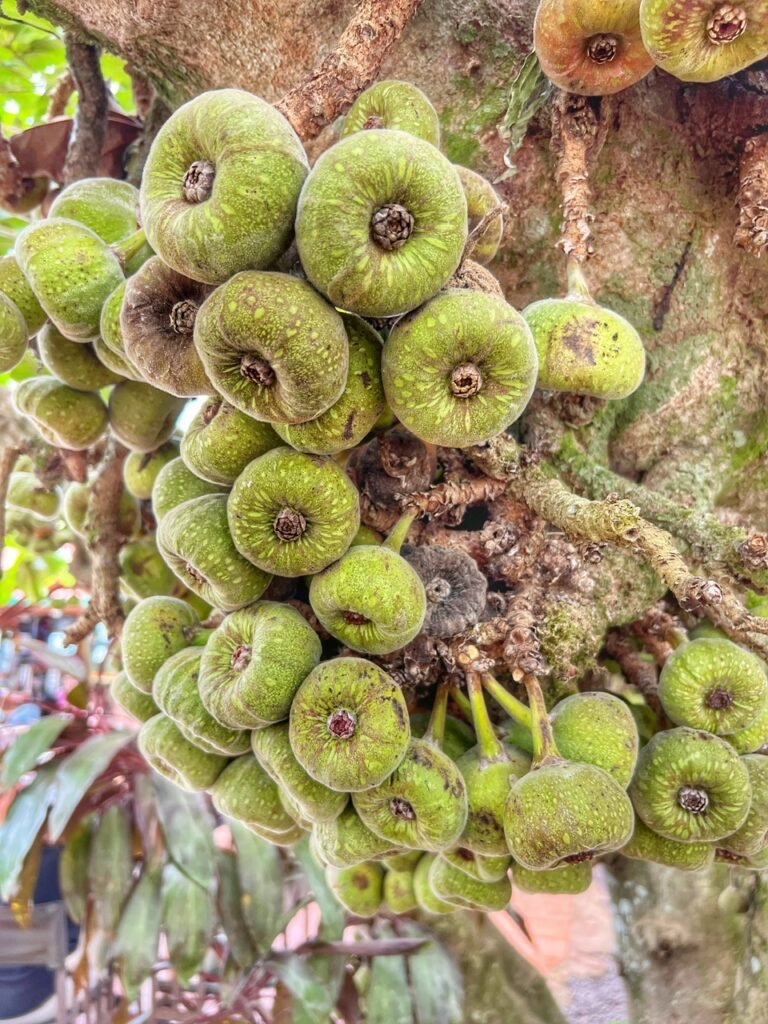
This tree looks a bit like it’s getting figgy ‘wit it, but we didn’t know it was an actual type of fig until our Seek app confirmed it. In fact, it’s a type of fig tree seen all over Asia noted for its big and round leaves. This is used as fodder in Nepal and interestingly, all over Iguazu.

This guy is one you definitely don’t wanna f%^ck with or you’ll be yelping a whole lot more of that word. This ant, clocking in at over an inch long (think about it) is the notorious bullet ant…the first we’ve ever seen in person. If you’ve never heard of it, it’s the insect known as having the worst sting in the world, which lasts for 24-hours and feels exactly like its name. The good thing is, we realized, that with their size, you can’t miss ‘em!
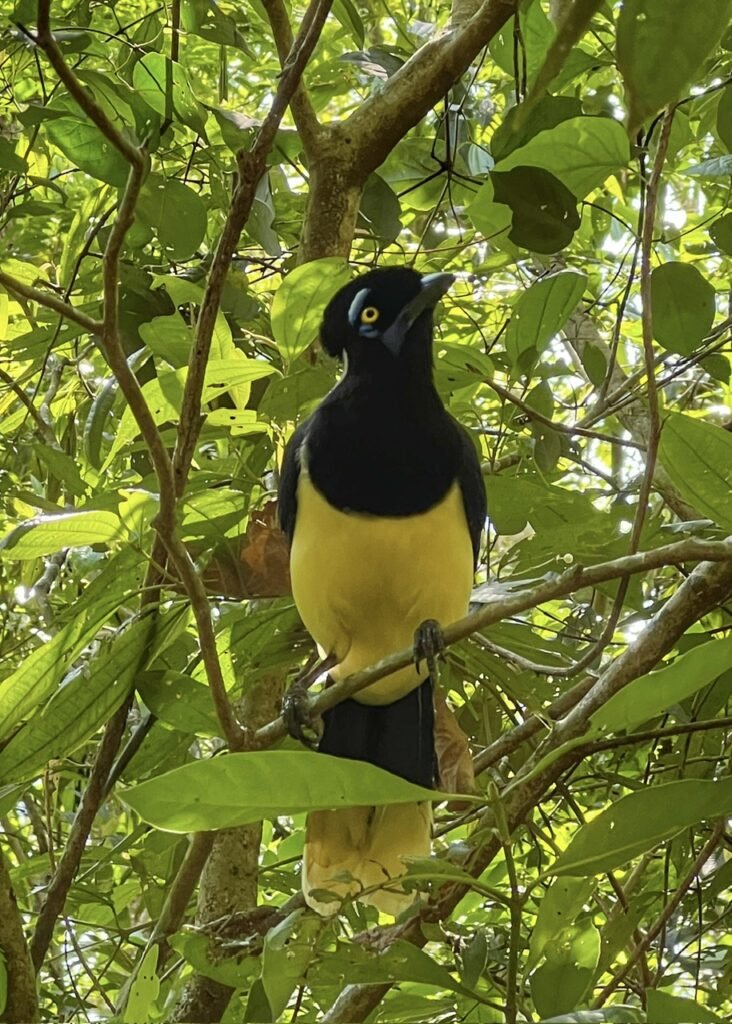
This cocky looking guy is the Plush-crested Jay (which includes the crows and their many allies). It is found in central-southern South America: in southwestern Brazil, Bolivia, Paraguay, Uruguay, and northeastern Argentina,
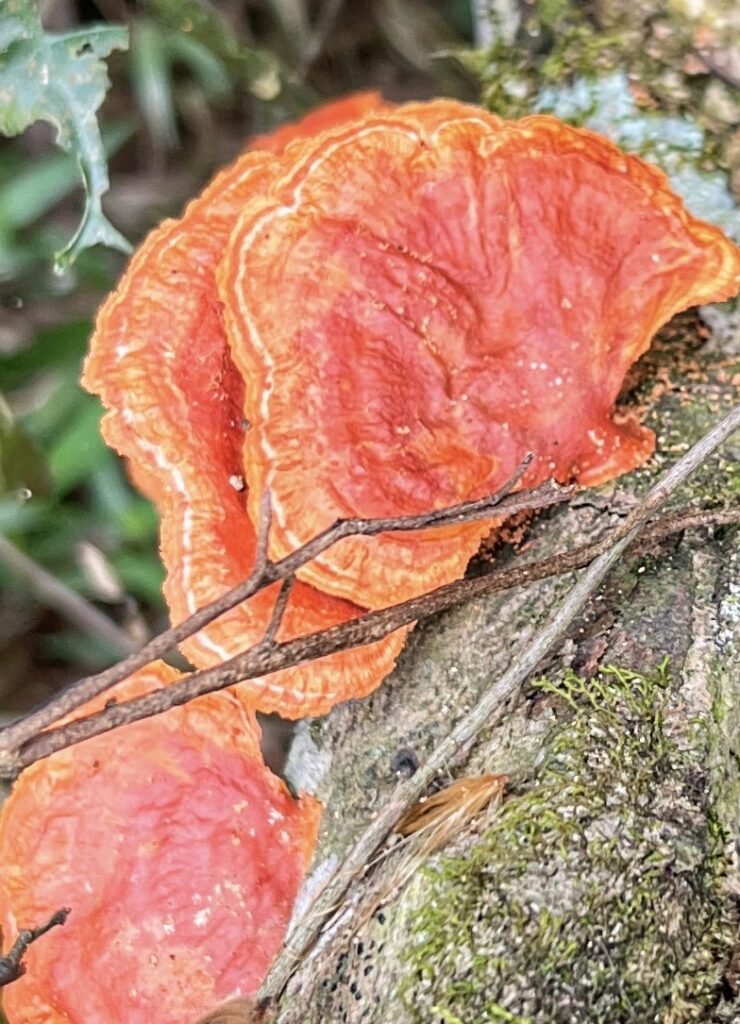
The trámetes sanguínea fungi is inedible but sure looks fancy!
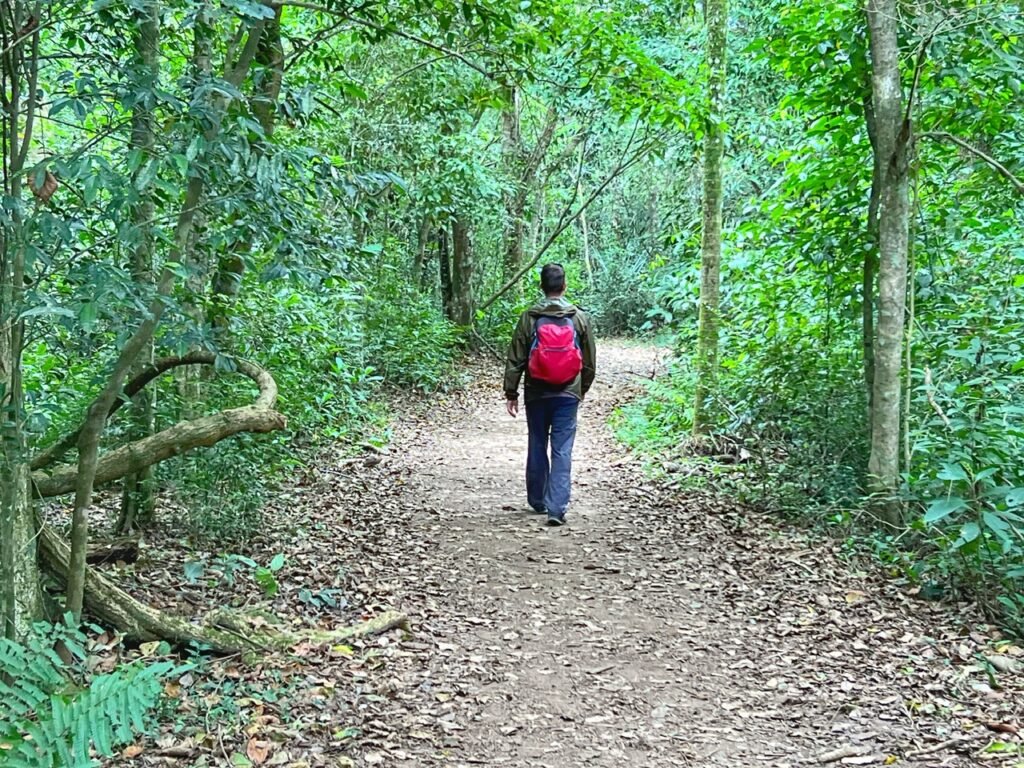
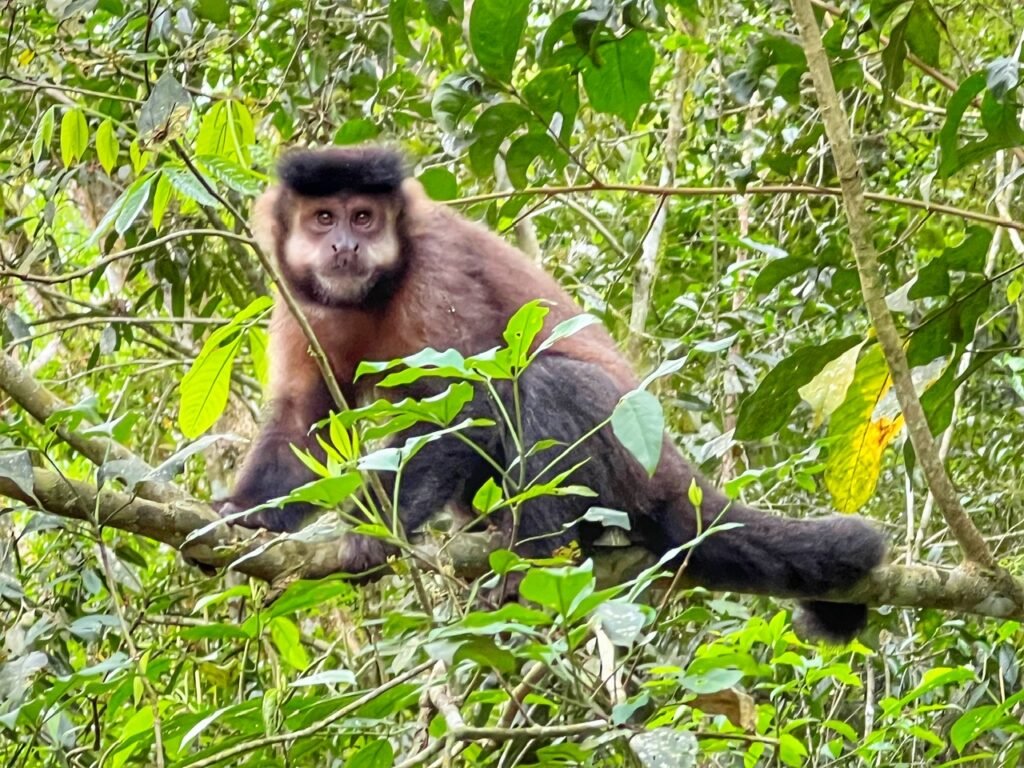
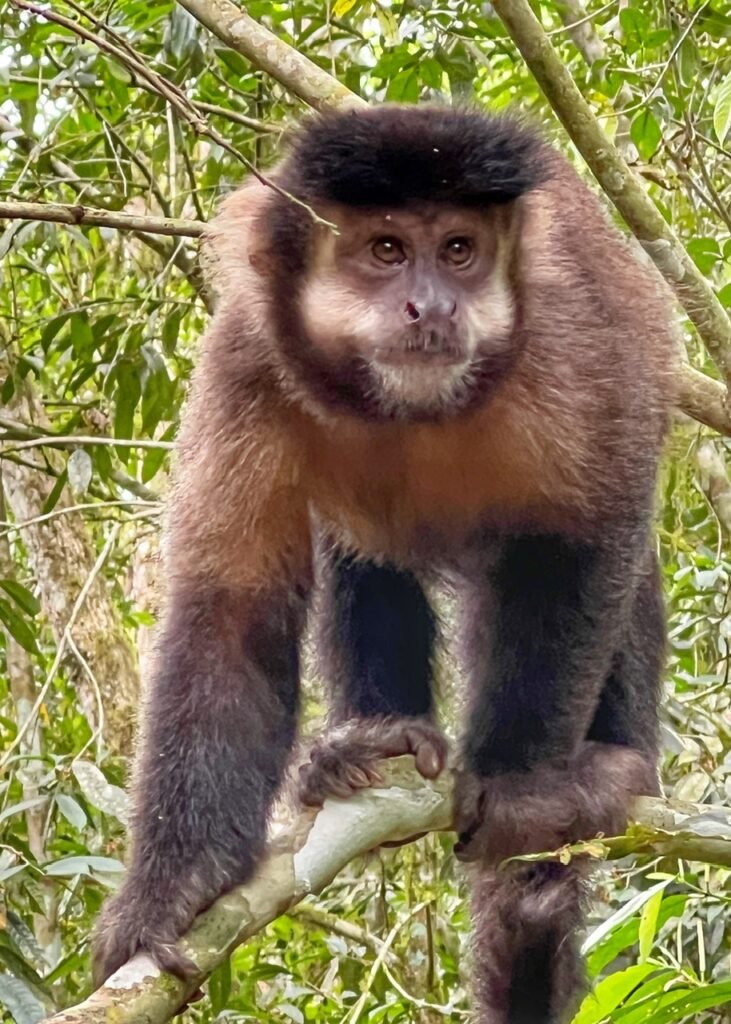
The Macuco Trail. Make sure you’ve got your mosquito spray for this one. The rest of the park isn’t nearly as bad.

The Hydaspes eighty-eight or little callicore.

The Argentine Black-and-white Tegu is an omnivorous species which inhabits the tropical rain forests, savannas, and semi-deserts of eastern and central South America. This one was about four feet long.
Crossing into Brazil

After wrapping up two days on the Argentina side, it was time for us to reluctantly cross back across the border into expensive Brasil. Fortunately, to help with the costs, we lined up a Couchsurf with Portuguese/English teacher Walter and his family, which ended up being a really great experience. Walter, his wife, and daughter Mary after they sweetly made us dinner on the second night. We had rice, beans, eggs, beets and tomatoes. His wife didn’t speak any English and Mary was learning. We still had some wonderful conversations, mostly comparing Brazil and US politics and situations. We stayed in their guest bedroom which had a separate entrance and bathroom. We continue to love and recommend Couchsurfing as a great way to meet locals and save money!

After dinner, dessert was served. A tray of sweet potatoes which amusingly, they picked up and ate like a banana. Perhaps one of the most unusual desserts we’ve ever had but now… that is definitely a good way to curb your sugar cravings.
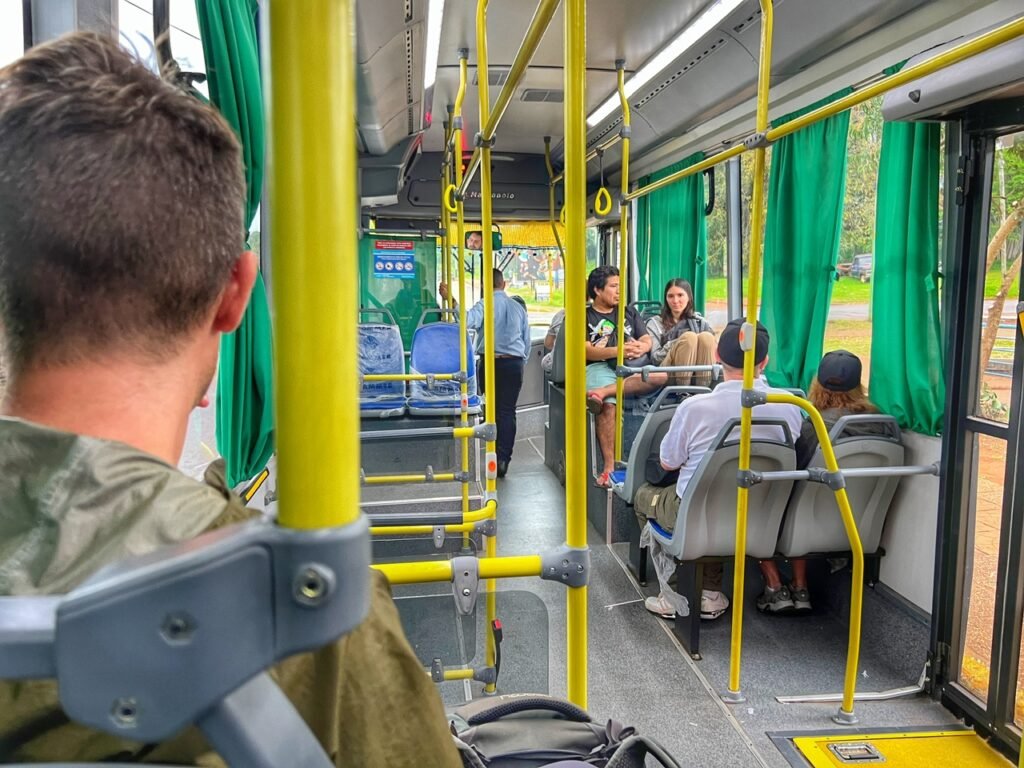
So…getting into Brazil was a bit of a mystery, but believe it or not, it was as simple as taking a LOCAL bus between the terminals of Puerto Iguazu in Argentina and Foz do Iguacu, Brazil. First time we’ve ever done this between borders so the setup was a little odd. Firstly, the fare was evidently negotiable. At first, the driver gave us a price three times what it was posted as and when we refused, he dropped it immediately. It ended up being $1.83 for both of us, which took a couple hours. Not that it was far, but because we had to deal with customs.

Heading into Argentine customs to get stamped out. Everyone on the bus had to do this.
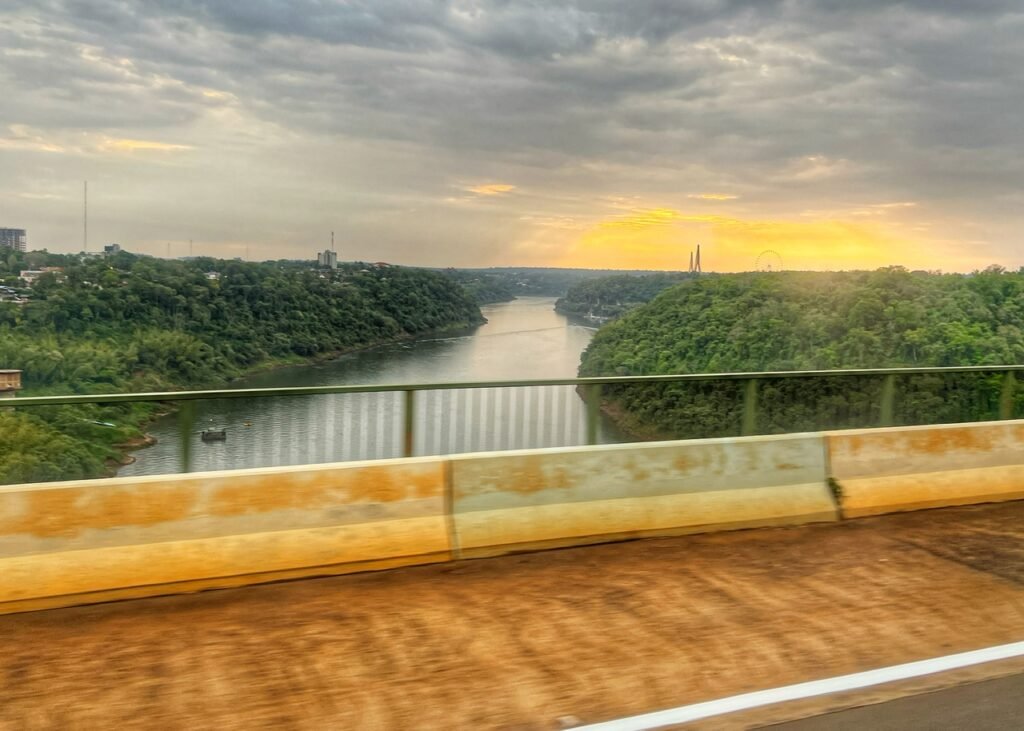
Crossing the Iguazu River and officially heading into Brazil.
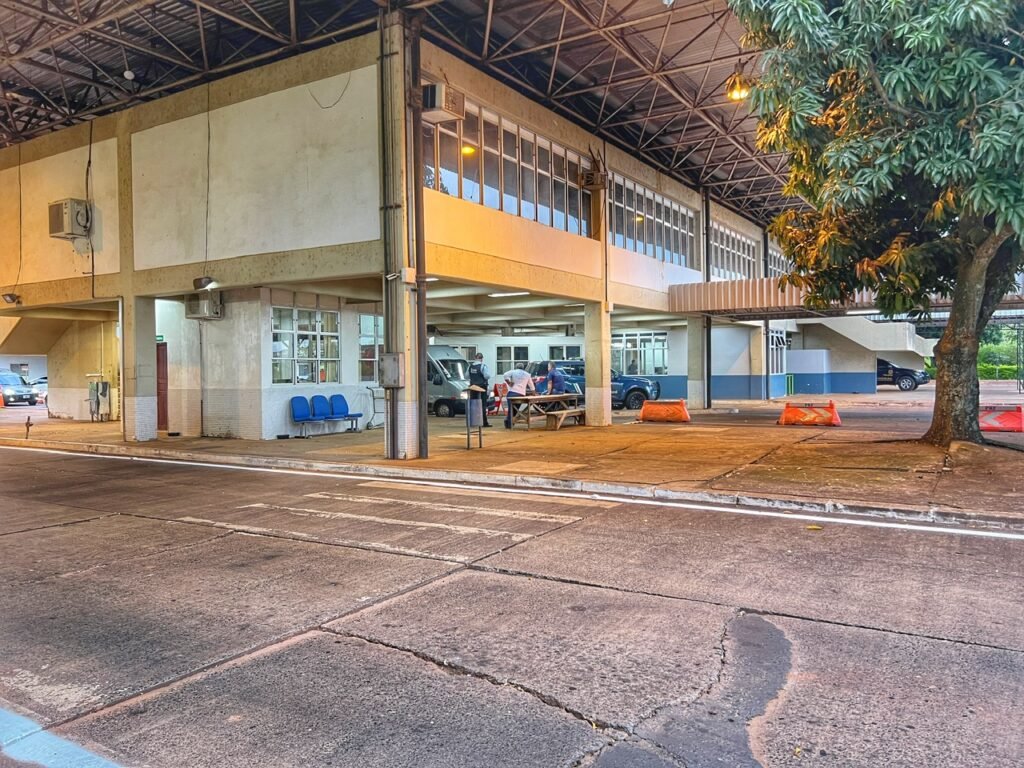
And arriving on the other side to Brazilian immigration. Curiously, no one on the bus was getting off to get stamped but we knew we needed one to make ourselves official. We thought the bus would wait for us, but it took off, leaving us at the border. After getting our stamps, we returned back to where the bus dumped us and fortunately about 30 minutes later, another bus rolled along. Since we’d gotten rid of all our pesos and didn’t have reals yet, we were nervous they’d charge again but fortunately we walked by and the driver said nothing!

Time to reward ourselves with the real reason we came to Brazil, our last official bowl of açaí. Oh, how we’ve missed you!

The next day, before heading to the park, we stopped to be transported to the Middle East at a Lebanese restaurant. Oh how we’ve missed you too. These itchy feet never ever stop!!
Iguazu Day Three: The Brazil Side

For our third and final day of Iguazu we headed to the Brazil side by taking a local bus from the Terminal Urbano station in the city of Foz do Iguacu. What makes the Brazil side different is that it offers breathtaking panoramic views of the entire falls system. However, after two mind-blowing days on the Argentina side, we found it a bit underwhelming. For this reason, we felt it would be best to be done first and with our budget, we probably would have skipped it all together. Don’t get us wrong, the falls are stunning no matter how you view them! Especially when you can add fancy photo effects. 😉
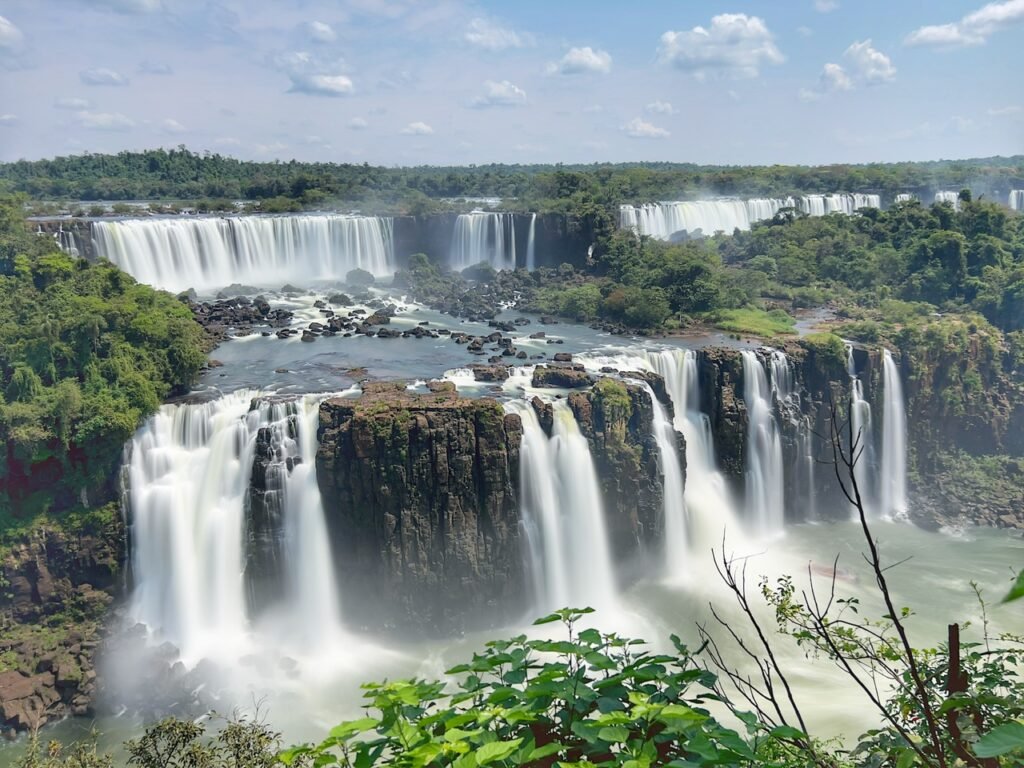
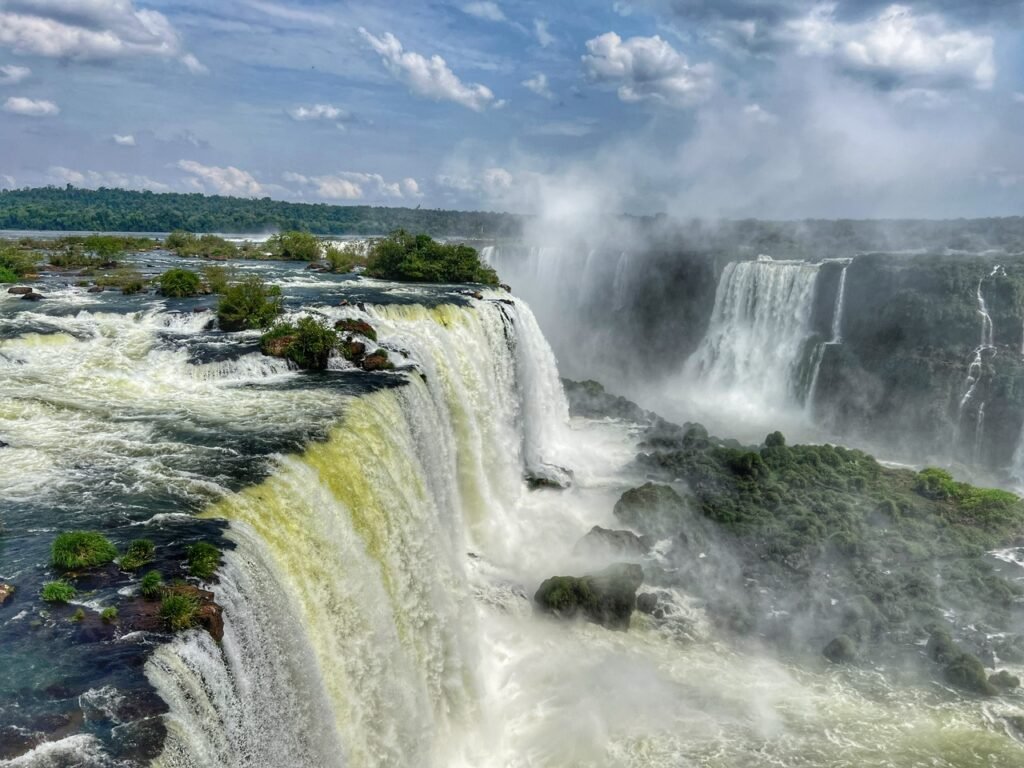
So how did the falls come to be? According to legend, a deity planned to marry a beautiful woman named Naipí, who fled with her mortal lover Tarobá in a canoe. In a rage, the deity sliced the river, creating the waterfalls and condemning the lovers to an eternal fall. At least it was a beautiful death!

The Brazil side is much smaller than Argentine side and features one very crammed, yet easy, walking trail running alongside the falls route. It also costs about $4 more per ticket making it a hefty admission fee for us.

However, it does allow you to get very up close and personal with one of the falls toward the end of the series.
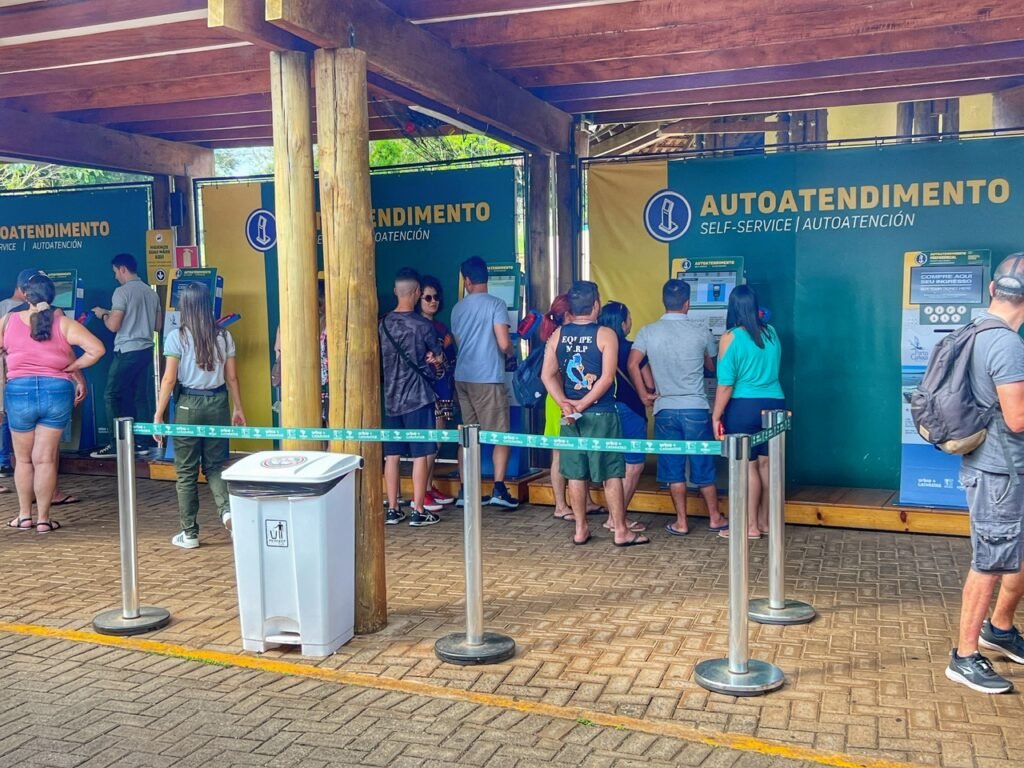
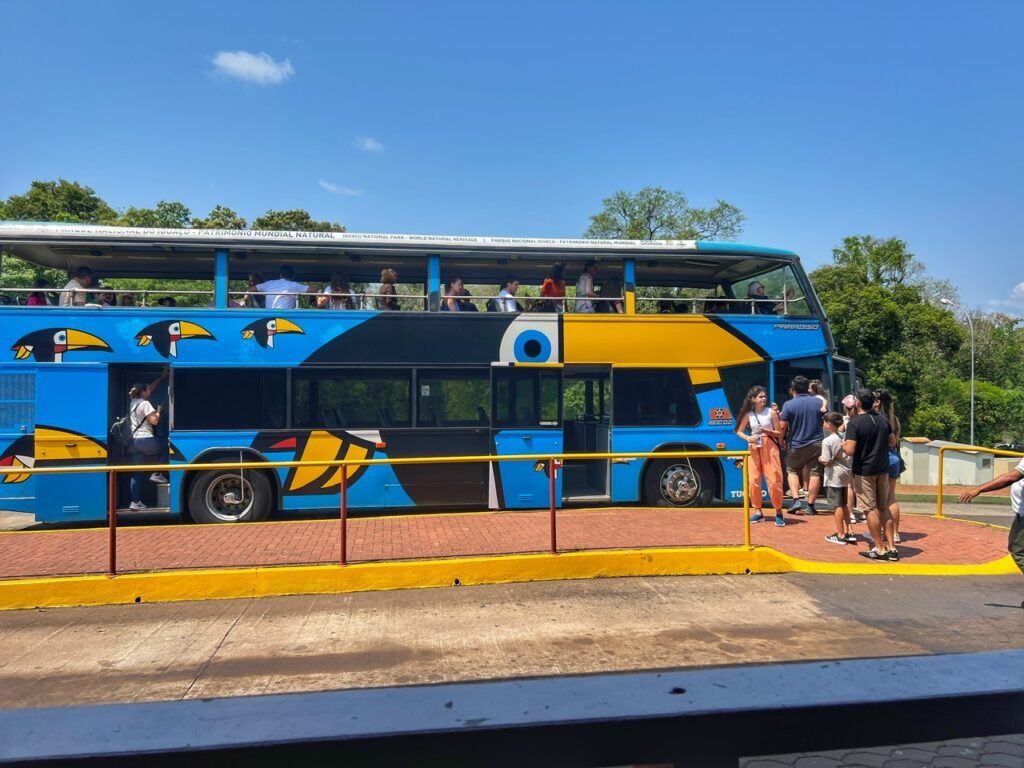
Iguazu Falls, one of the world’s natural wonders records one and a half million visitors a year. As mentioned, it’s easy to visit independently from the Terminal Urbano station in Foz do Iguacu and costs about 5 Reales/$2/each round trip. Look for the big signs labeled “Cataratas” and climb onto one of the accordion buses for the ~45 minute ride. When you arrive to the park, you’ll know you’re in more organized and advanced Brazil because you’re greeted with robot concierge to check you in and suck $17/each off your credit card. The machine gives you a bus number so you then climb aboard a double decker bus for your official entry into the park.
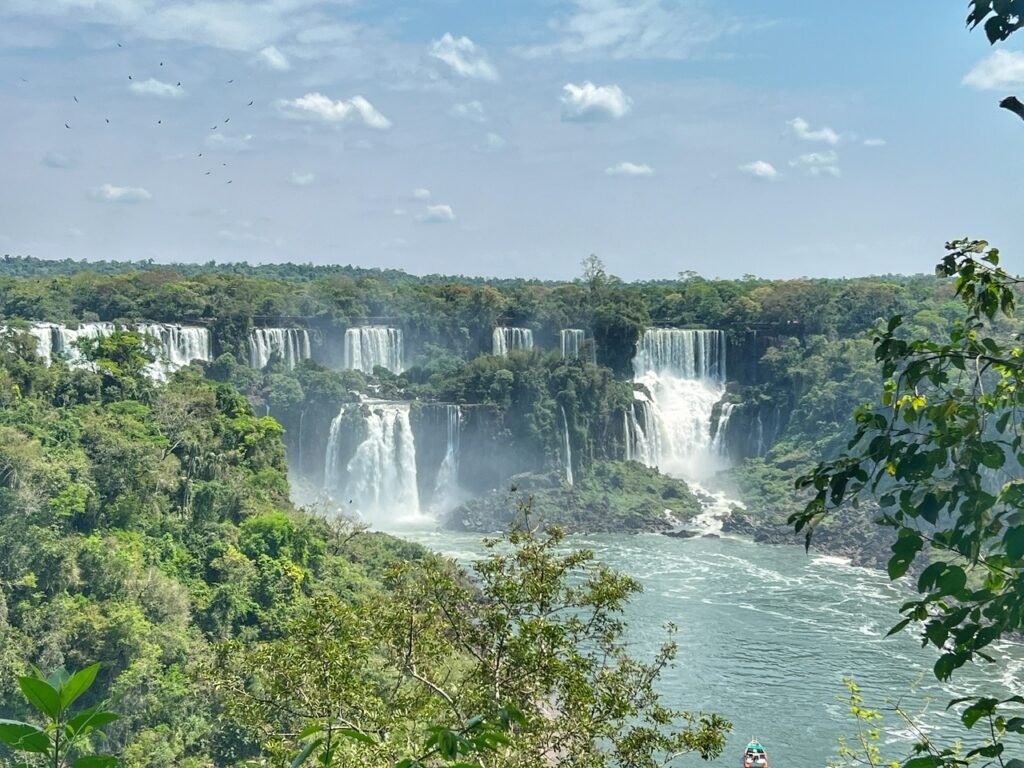
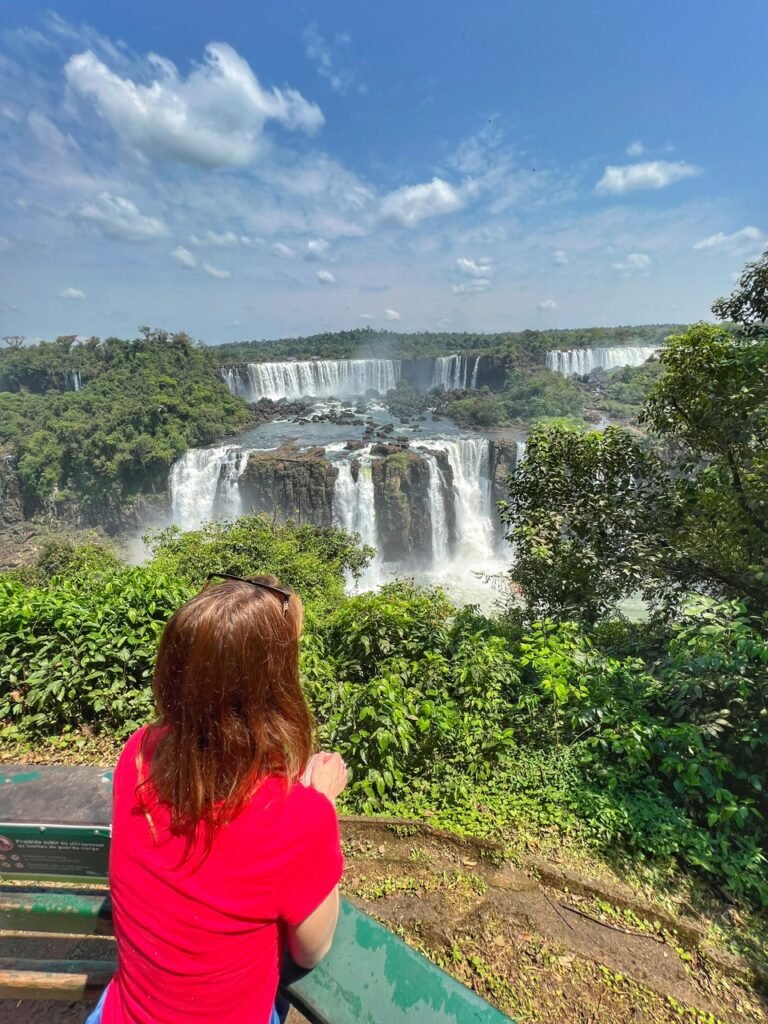
It drops you off at the main and only included trail with the other hoards to take turns cramming into the railings for photos and selfies. There were at least 30 people surrounding Mandy during this photo.
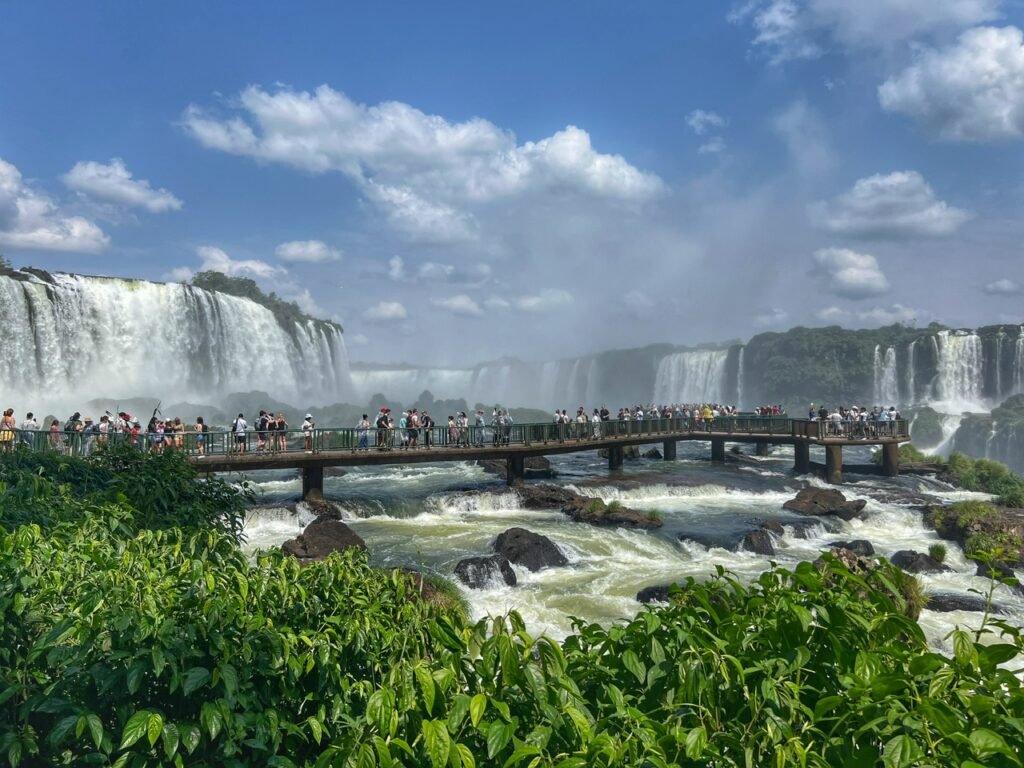
A good illustration of this is the Congo line leading out to the Devil’s Throat observation platform.
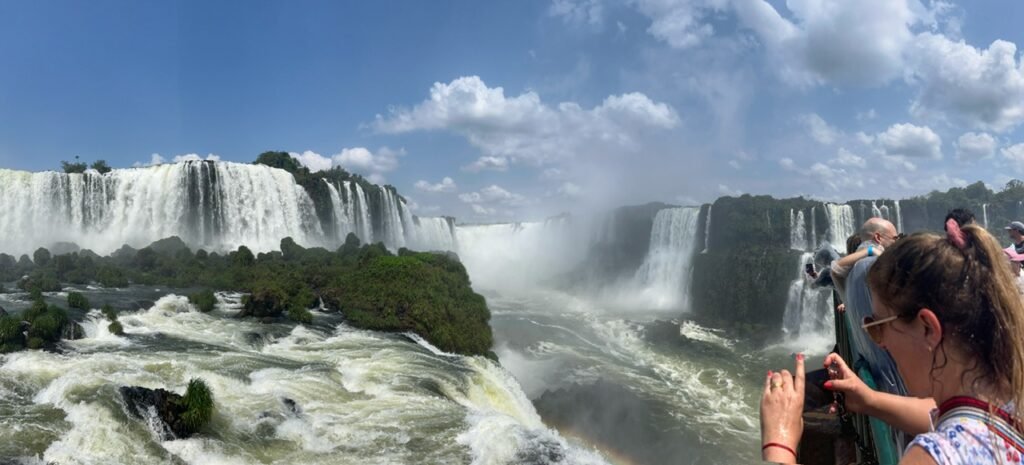
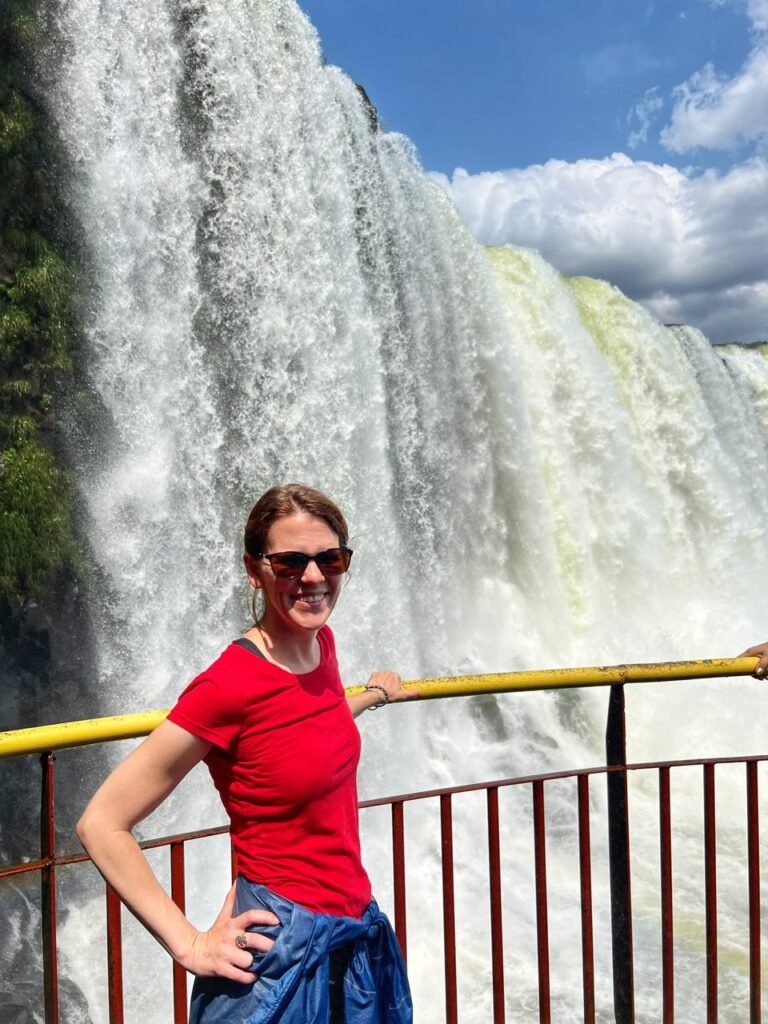
It was a hot day so the spray felt amazing! Other than getting in the falls on the Gran Adventura, this seemed to be the closest we were gonna get.
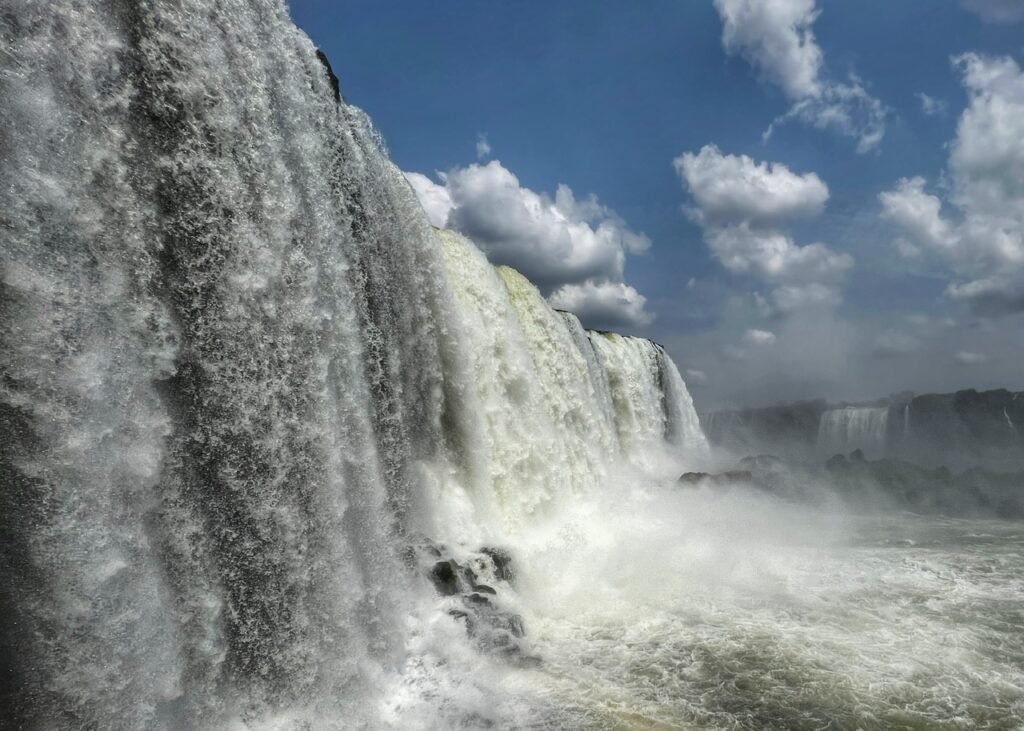

It really was unbelievably gorgeous. Peeking out from the gift shop and seeing that view felt even more wild. Just like the settlers saw it long ago!
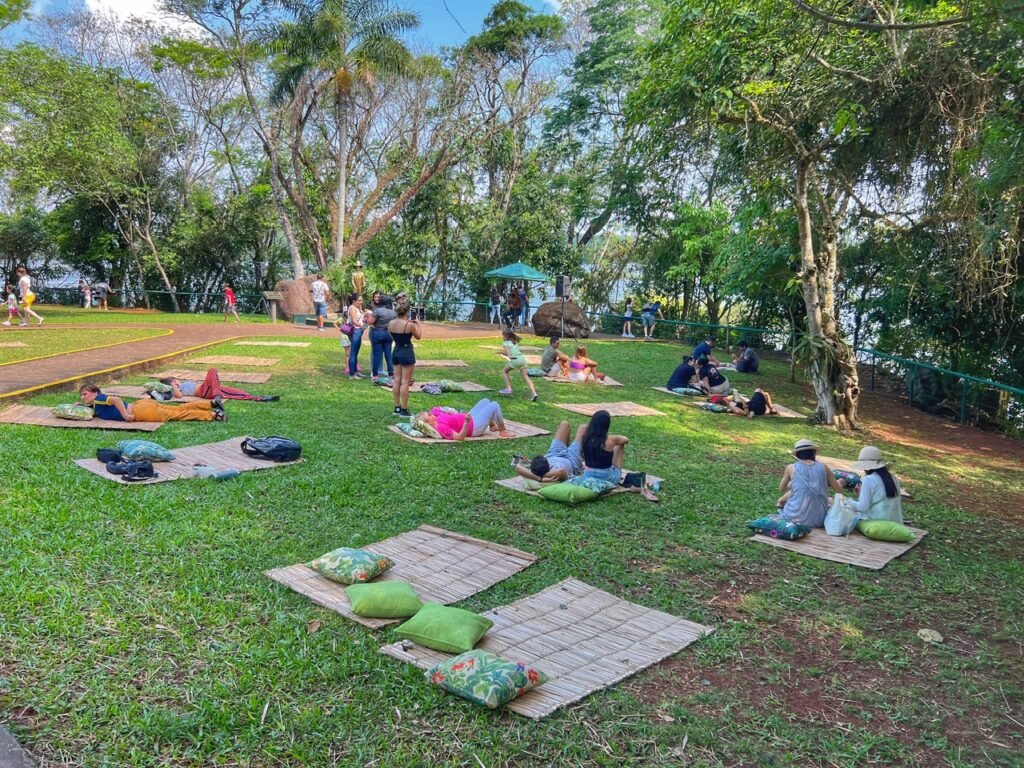
After the trail, they had live music playing and pallets in the grass for lying down. This is the jungle though. We’re not stupid. 🕷️ 🐜 🐞 I didn’t matter, however, some mysterious critter(???) had already gotten Mandy the day before. We just had yet to discover it.



